剑桥国际英语词典1
- 格式:doc
- 大小:45.00 KB
- 文档页数:2
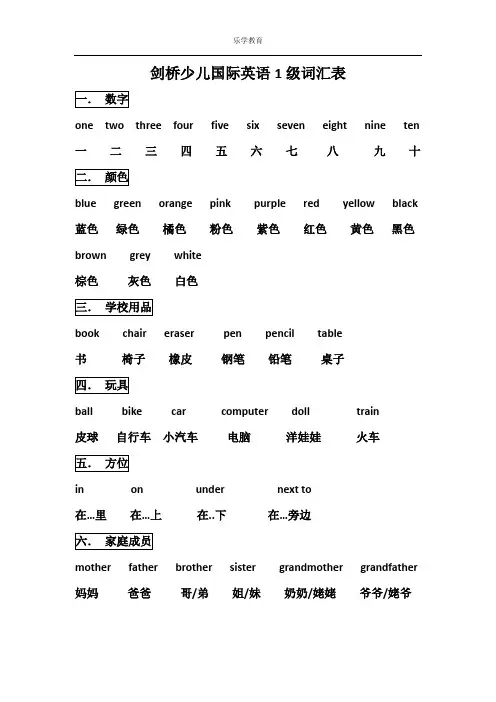
剑桥少儿国际英语1级词汇表one two three four five six seven eight nine ten 一二三四五六七八九十blue green orange pink purple red yellow black 蓝色绿色橘色粉色紫色红色黄色黑色brown grey white棕色灰色白色book chair eraser pen pencil table书椅子橡皮钢笔铅笔桌子ball bike car computer doll train皮球自行车小汽车电脑洋娃娃火车in on under next to在…里在…上在..下在…旁边mother father brother sister grandmother grandfather 妈妈爸爸哥/弟姐/妹奶奶/姥姥爷爷/姥爷old young ugly beautiful happy sad tall 老的年轻的丑的漂亮的高兴的伤心的高的short small big long clean dirty矮的小的大的长的干净的脏的face ears eyes mouth nose teeth arm foot 脸耳朵眼睛嘴鼻子牙齿胳膊脚feet hand leg tail脚手腿尾巴crocodile elephant monkey giraffe hippo snake鳄鱼大象猴子长颈鹿河马蛇tiger老虎jacket shoes skirt socks trousers T-shirt 夹克衫鞋短裙袜子裤子半袖play football play basketball play tennis play the guitar踢足球打篮球打网球弹吉他play the piano swim ride a bike弹钢琴游泳骑自行车boat bus helicopter lorry motorbike plane 小船公交车直升机货车摩托车飞机bathroom bedroom dining room hall kitchen浴室卧室餐厅走廊厨房living room客厅apple banana burger cake chocolate ice cream苹果香蕉汉堡蛋糕巧克力冰激淋orange and but or橙子和但是或者,还是1.Hello,I’m …What’s your name ? 你好,我是。
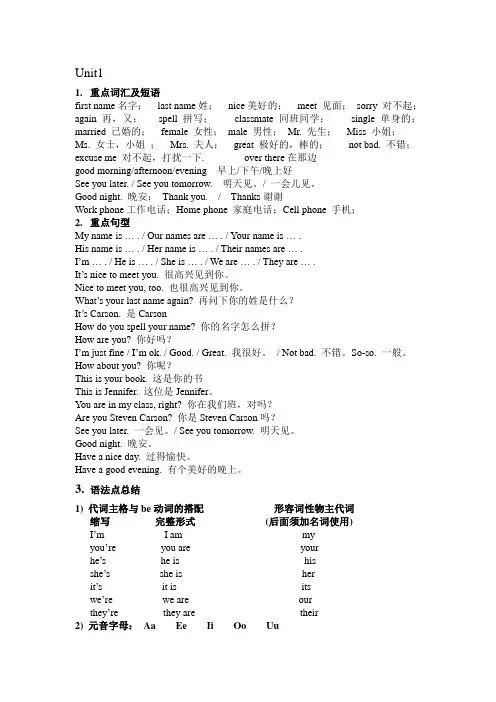
1.重点词汇及短语first name名字;last name姓;nice美好的;meet 见面;sorry 对不起;again 再,又;spell 拼写;classmate同班同学;single 单身的;married 已婚的;female 女性;male 男性;Mr. 先生;Miss 小姐;Ms. 女士,小姐;Mrs. 夫人;great 极好的,棒的;not bad. 不错;excuse me 对不起,打扰一下. over there在那边good morning/afternoon/evening 早上/下午/晚上好See you later. / See you tomorrow. 明天见。
/ 一会儿见。
Good night. 晚安;Thank you. / Thanks谢谢Work phone工作电话;Home phone 家庭电话;Cell phone 手机;2.重点句型My name is … . / Our names are … . / Your name is … .His name is … . / Her name is … . / Their names are … .I’m … . / He is … . / She is … . / We are … . / They are … .It’s nice to meet you. 很高兴见到你。
Nice to meet you, too. 也很高兴见到你。
What’s your last name again? 再问下你的姓是什么?It’s Carson. 是CarsonHow do you spell your name? 你的名字怎么拼?How are you? 你好吗?I’m just fine / I’m ok. / Good. / Great. 我很好。
/ Not bad. 不错。
So-so. 一般。
How about you? 你呢?This is your book. 这是你的书This is Jennifer. 这位是Jennifer。

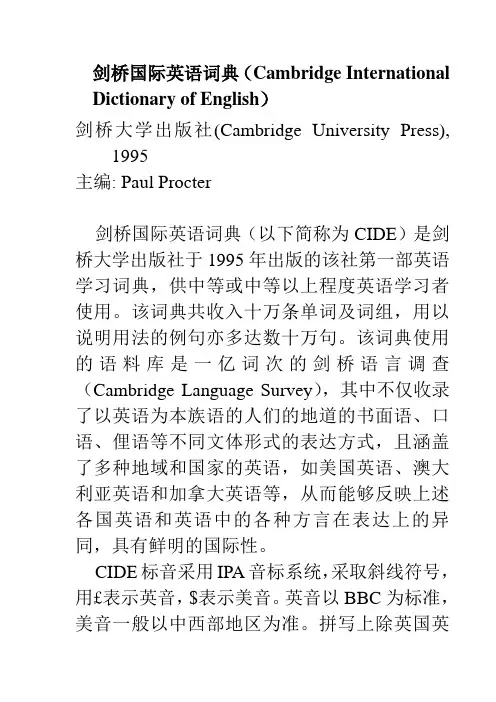
剑桥国际英语词典(Cambridge International Dictionary of English)剑桥大学出版社(Cambridge University Press), 1995主编: Paul Procter剑桥国际英语词典(以下简称为CIDE)是剑桥大学出版社于1995年出版的该社第一部英语学习词典,供中等或中等以上程度英语学习者使用。
该词典共收入十万条单词及词组,用以说明用法的例句亦多达数十万句。
该词典使用的语料库是一亿词次的剑桥语言调查(Cambridge Language Survey),其中不仅收录了以英语为本族语的人们的地道的书面语、口语、俚语等不同文体形式的表达方式,且涵盖了多种地域和国家的英语,如美国英语、澳大利亚英语和加拿大英语等,从而能够反映上述各国英语和英语中的各种方言在表达上的异同,具有鲜明的国际性。
CIDE标音采用IPA音标系统,采取斜线符号,用£表示英音,$表示美音。
英音以BBC为标准,美音一般以中西部地区为准。
拼写上除英国英语与美音分别用Br与Am标出外,还用Br/Am 注明是英美通用的形式。
此外, CIDE还进一步用“*”标明英国常用形式,用“a”标明美国常用的形式。
CIDE在前言中开宗明义的表明其编纂原则为清晰、简明,其用于释义的基本词汇不足2000,置于附录中,并详尽地规定了七条释义选词标准:1、选择可用于解释其它词的用语;2、采用使用频率高的常用词;3、使用英美语中具有同样意义的词语;4、选用学习者易于理解的词语;5、避免使用过时的词语;6、避免使用与其它英语词汇常混淆的词语;7、避免使用与外国词语相混淆的词语。
这样明确而详细地在英语学习者词上列出选择释义词标准的词典还是首次。
在释义方式上采用短语释义及句子释义两种方法。
中心词的释义一般用短语。
如果该词语义较为丰富,则再用短语或句子对其语义各侧面进行解释。
如词条主定义为combining form the equipment, clothes etc, that you use to do a particular activity.后收入例证Police in a riot gear (= protective clothing) arrived to control the protestors. 该句中gear的含义与主定义有一定差别,CIDE就在括号内用短语对其进行阐释。
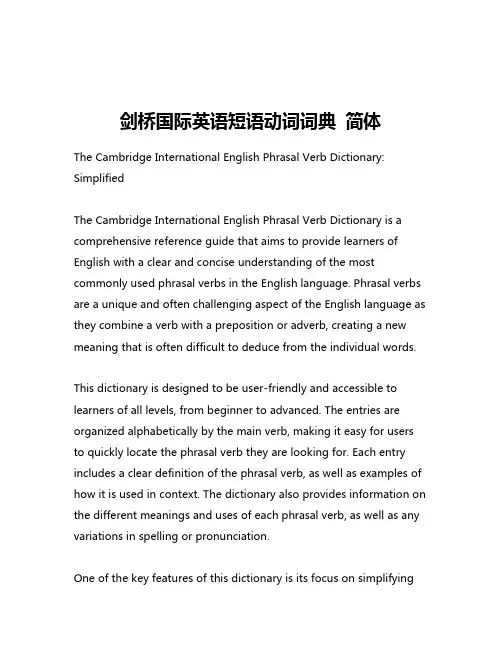
剑桥国际英语短语动词词典简体The Cambridge International English Phrasal Verb Dictionary: SimplifiedThe Cambridge International English Phrasal Verb Dictionary is a comprehensive reference guide that aims to provide learners of English with a clear and concise understanding of the most commonly used phrasal verbs in the English language. Phrasal verbs are a unique and often challenging aspect of the English language as they combine a verb with a preposition or adverb, creating a new meaning that is often difficult to deduce from the individual words.This dictionary is designed to be user-friendly and accessible to learners of all levels, from beginner to advanced. The entries are organized alphabetically by the main verb, making it easy for users to quickly locate the phrasal verb they are looking for. Each entry includes a clear definition of the phrasal verb, as well as examples of how it is used in context. The dictionary also provides information on the different meanings and uses of each phrasal verb, as well as any variations in spelling or pronunciation.One of the key features of this dictionary is its focus on simplifyingthe language used to explain the phrasal verbs. Many traditional dictionaries can be overwhelming for non-native speakers, as the explanations are often complex and dense. The Cambridge International English Phrasal Verb Dictionary, on the other hand, uses simple and straightforward language to ensure that the definitions are easy to understand and remember.Another notable aspect of this dictionary is its inclusion of common collocations and idiomatic expressions that feature the phrasal verbs. This is particularly useful for learners who are looking to improve their fluency and natural-sounding speech, as these expressions are often used in everyday conversation.The dictionary also includes a comprehensive introduction that provides an overview of the structure and function of phrasal verbs in the English language. This introduction covers topics such as the different types of phrasal verbs, the differences between transitive and intransitive phrasal verbs, and the importance of context in understanding their meaning.One of the key benefits of the Cambridge International English Phrasal Verb Dictionary is its ability to help learners of English improve their communication skills. Phrasal verbs are a ubiquitous feature of the English language, and mastering their use is essential for effective communication in a variety of contexts, from academicand professional settings to social and personal interactions.By providing a comprehensive and user-friendly reference guide, the dictionary helps learners to better understand the nuances of phrasal verbs and how to use them appropriately in their own speech and writing. This can be particularly beneficial for non-native speakers who may struggle with the complexity of the English language and the idiomatic nature of phrasal verbs.In addition to its practical applications, the Cambridge International English Phrasal Verb Dictionary also serves as a valuable resource for language educators and researchers. Teachers can use the dictionary to develop lesson plans and activities that focus on phrasal verbs, while linguists and language scholars can use it to further their understanding of this unique aspect of the English language.Overall, the Cambridge International English Phrasal Verb Dictionary is a valuable resource for anyone looking to improve their command of the English language. Its user-friendly design, comprehensive coverage, and focus on simplifying the language make it an essential tool for learners of all levels. Whether you are a student, a professional, or simply someone who loves the English language, this dictionary is sure to be a valuable addition to your linguistic toolkit.。
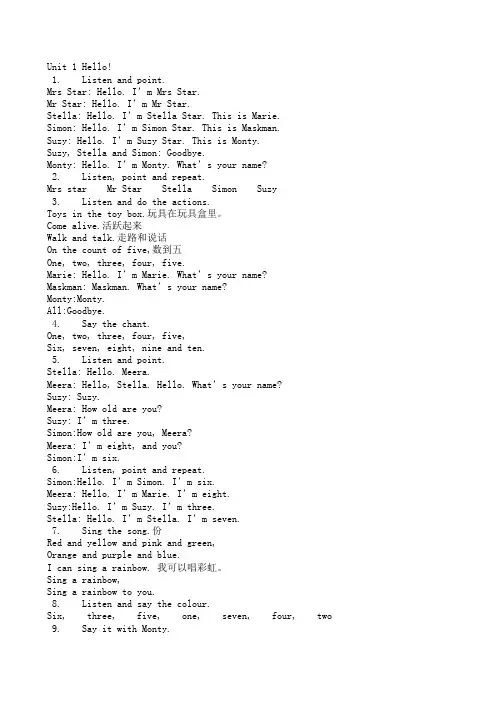
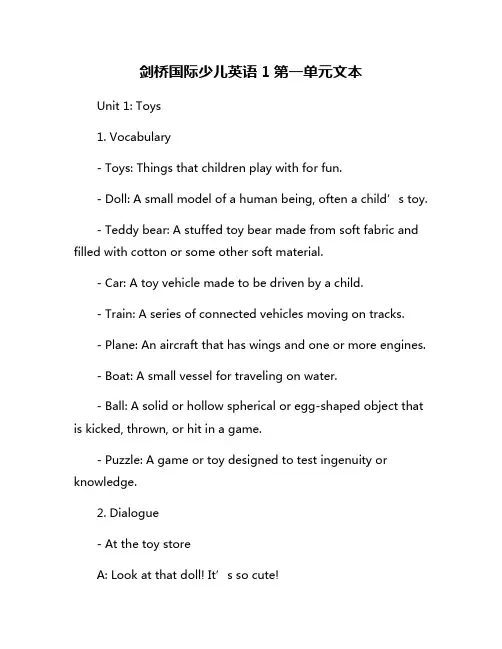
剑桥国际少儿英语1第一单元文本Unit 1: Toys1. Vocabulary- Toys: Things that children play with for fun.- Doll: A small model of a human being, often a child’s toy.- Teddy bear: A stuffed toy bear made from soft fabric and filled with cotton or some other soft material.- Car: A toy vehicle made to be driven by a child.- Train: A series of connected vehicles moving on tracks.- Plane: An aircraft that has wings and one or more engines.- Boat: A small vessel for traveling on water.- Ball: A solid or hollow spherical or egg-shaped object that is kicked, thrown, or hit in a game.- Puzzle: A game or toy designed to test ingenuity or knowledge.2. Dialogue- At the toy storeA: Look at that doll! It’s so cute!B: Yes, it is. I think my sister would love it.A: And what about the teddy bear? It’s adorable!B: Oh, she already has one. But I think that car would be perfect for her.A: Great idea! And what about the train set for your little brother?B: Hmm, I think he would prefer the plane. He loves flying.A: Sounds like a plan. Let’s get the car, the plane, and the puzzle.3. Read and learn- The boy is playing with a ball in the garden.- The girl is putting together a puzzle on the table.- The children are sailing a boat on the pond.- The kids are playing with their toys in the room.4. Activity- Draw your favorite toy and write a few sentences about why you like it.5. Fun fact- The teddy bear was named after President Theodore Roosevelt, who was often referred to as “Teddy.”。
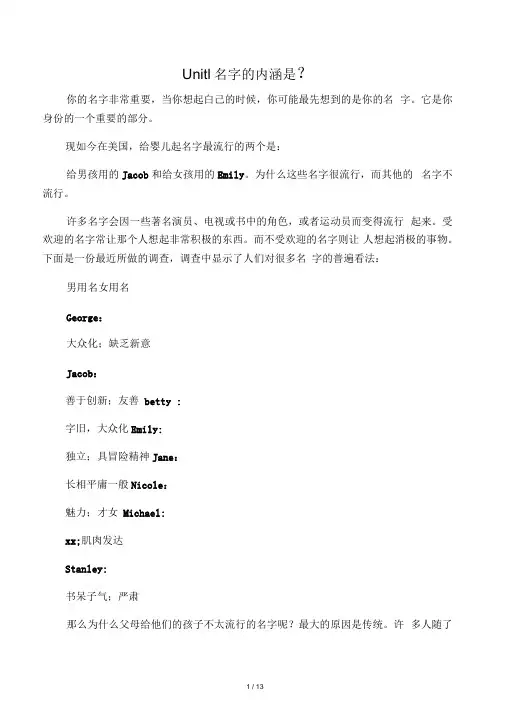
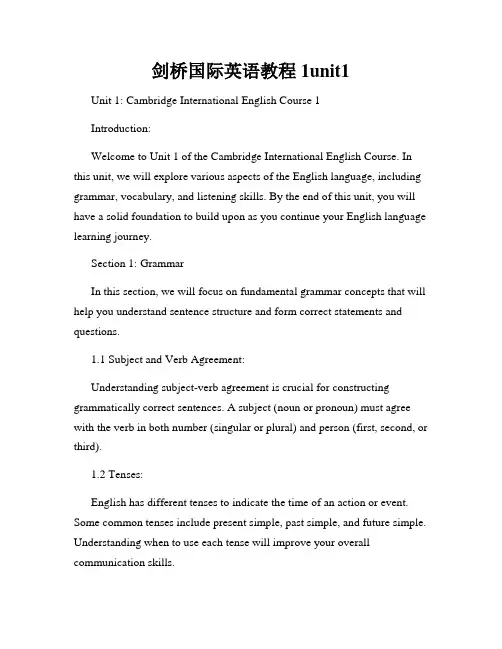
剑桥国际英语教程1unit1Unit 1: Cambridge International English Course 1Introduction:Welcome to Unit 1 of the Cambridge International English Course. In this unit, we will explore various aspects of the English language, including grammar, vocabulary, and listening skills. By the end of this unit, you will have a solid foundation to build upon as you continue your English language learning journey.Section 1: GrammarIn this section, we will focus on fundamental grammar concepts that will help you understand sentence structure and form correct statements and questions.1.1 Subject and Verb Agreement:Understanding subject-verb agreement is crucial for constructing grammatically correct sentences. A subject (noun or pronoun) must agree with the verb in both number (singular or plural) and person (first, second, or third).1.2 Tenses:English has different tenses to indicate the time of an action or event. Some common tenses include present simple, past simple, and future simple. Understanding when to use each tense will improve your overall communication skills.Section 2: VocabularyBuilding your vocabulary is essential for effective communication. In this section, we will explore strategies to expand your word bank and improve your language proficiency.2.1 Word Families:Word families consist of a base word and its related forms (nouns, verbs, adjectives, adverbs). Learning word families helps you understand how words are connected and how their meanings can be extended.2.2 Synonyms and Antonyms:Knowing synonyms (words with similar meanings) and antonyms (words with opposite meanings) allows you to express yourself more precisely and avoid repetition in your speech and writing.Section 3: Listening SkillsDeveloping your listening skills is crucial for engaging in conversations and understanding native speakers. In this section, we will provide strategies to enhance your listening abilities.3.1 Active Listening:Active listening involves focusing on the speaker, paying attention to verbal and nonverbal cues, and understanding the main ideas and supporting details. Practicing active listening will improve your overall comprehension skills.3.2 Note-Taking:Taking notes while listening helps you retain information and review key points later. Develop a system that works for you, whether it's using bullet points, diagrams, or abbreviations.Conclusion:Congratulations on completing Unit 1 of the Cambridge International English Course. By focusing on grammar, vocabulary, and listening skills, you have taken significant steps towards improving your English language proficiency. Remember to practice regularly and apply what you have learned in real-life situations. Good luck on your language learning journey!。
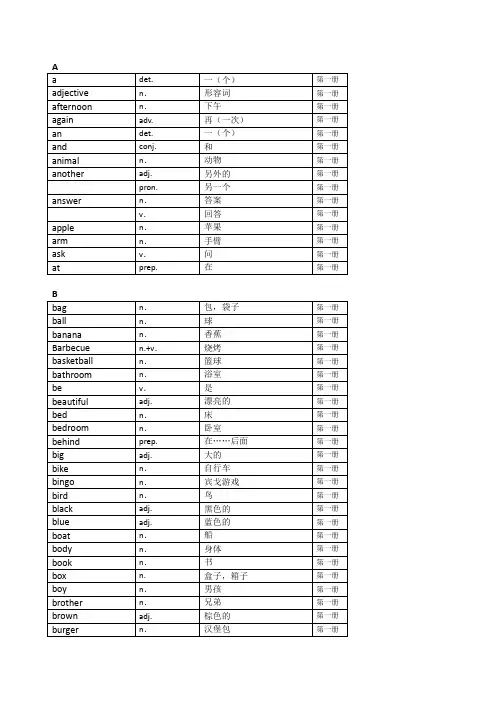
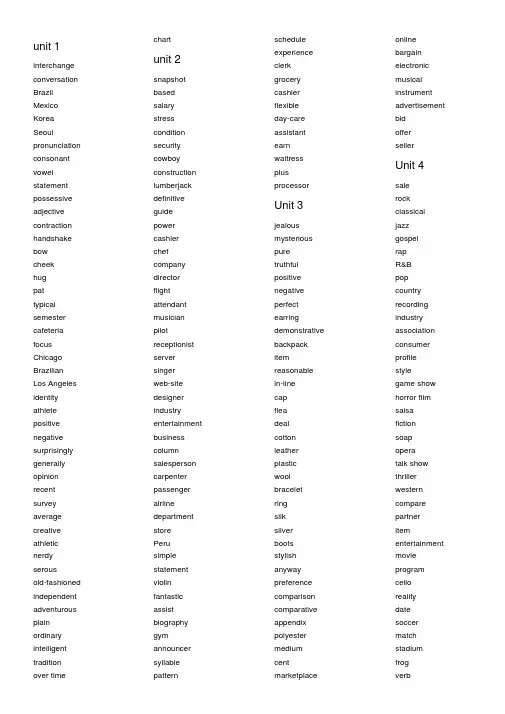
unit 1 interchange conversation Brazil Mexico KoreaSeoul pronunciation consonant vowel statement possessive adjective contraction handshake bowcheekhugpattypical semester cafeteria focus Chicago BrazilianLos Angeles identity athlete positive negative surprisingly generally opinion recent survey average creative athletic nerdy serousold-fashioned independent adventurous plain ordinary intelligent traditionover time chartunit 2snapshotbasedsalarystressconditionsecuritycowboyconstructionlumberjackdefinitiveguidepowercashierchefcompanydirectorflightattendantmusicianpilotreceptionistserversingerweb-sitedesignerindustryentertainmentbusinesscolumnsalespersoncarpenterpassengerairlinedepartmentstorePerusimplestatementviolinfantasticassistbiographygymannouncersyllablepatternscheduleexperienceclerkgrocerycashierflexibleday-careassistantearnwaitressplusprocessorUnit 3jealousmysteriouspuretruthfulpositivenegativeperfectearringdemonstrativebackpackitemreasonablein-linecapfleadealcottonleatherplasticwoolbraceletringsilksilverbootsstylishanywaypreferencecomparisoncomparativeappendixpolyestermediumcentmarketplaceonlinebargainelectronicmusicalinstrumentadvertisementbidoffersellerUnit 4salerockclassicaljazzgospelrapR&Bpopcountryrecordingindustryassociationconsumerprofilestylegame showhorror filmsalsafictionsoapoperatalk showthrillerwesterncomparepartneritementertainmentmovieprogramcellorealitydatesoccermatchstadiumfrogverbChristina Aguilera scaneventmultiplehitsingle generation highlightcareerOlympicstar search talentDisneytalentBritney Spears Justin Timberlake Genie in a Bottle Lady Marmalade closing ceremonysaltUtahVocalGrammyoverallthrilledroller-coasterfanUnit 5CousinNieceNephewsister-in-law great grandmother husbandsinglemarried daughterrelate government secretprojectwildlife photographer AmazonCollege University CarpenterPresentContinuousAbroadForeignlanguagetypicalpercentagepercenttelevisionadultmarryfactonlychildPeruQuantifierCoupleVotealoneprogrammeradministratornowthatprogramunfortunatelyhouseholdchorebenefitsolutionUnit 6exercisefitnessactivitysoftballsoccerweight trainingtreadmillstretchjoggingparticipationaerobicsbaseballbicyclingin-line skatingyogafitlift weightsseriouslyhardlycouchvideogameadverbfrequencygympollregularshapeworkoutpracticeguitarcoupleliveboxingsumobungeefreaktipaveragechatrelaxtypeservingjunkvitamindescribefairlyidealphysicalrarelytotalpointquizadd upscorematchoriginalguessUnit 7leisuregardeningorderkaraokedowntownSpanishsimplepastfocusirregularregularappendixspecialunfortunatelybrokeinvitechoreactivityvacationlaundryphotocopybowlexcellentfantasticwaveamazingincrediblecontractionwholefoggyusualIstanbulAcapulcojewelryMariachiterrificdisasterEaster IslanduniversitystonestatuemoaicaveIoranaspameditatevegetariansnorkelArcticUnit 8neighborhoodpowerdefinitionbarberlaundromatstationarystore agency grocery theater haircut reservation drugstore neighbor movepine preposition acrossfrom opposite avenue cornergasgym department plazamaple national main reduction reduce aquarium common complaint barkprivacykidyard cleanliness garbagecut apartment downtown convenient Korean parking garagecrimealarm quantifier count noncount nounpublic transportation traffic adroommatebulletinavailablecampusutilityscanBrazilPakistanRomaniaThailandsidewalkcrowdedcolorfultraditionalbandAstoriaqueenmostlyGreekresidentblendtrulymulticulturalsurroundadoptAstoriaMexicantortillarentreasonableinexpensiveapartmentroomycharacteristiccommitteecommunityrecreationalfacilitybotanicalarcadeamusementrinkpathskateboardcurrentlyUnit 9appearanceexpressiondescribeblondstraightcurlybaldmustachemiddle-agedelderlyhandsomefairlymediumheightgorgeousbeardlengthdarklightcontactlensescompareattachin our late teensbutton-downbeltdress shoesslackscargopantsstriped tightspurseplaiditemclassiccasualfunkymake itconcertlabelmodifiersparticipleprepositionguyattractiveemphasizecontrasthip-hopteenagersimplyurbanbeattypicalloose-fittingbaggyhikingbootslogosathleticDetroitChicagotrendybandpopularitysensationMelanieManchesterprideLev’sEvanstonIllinoisperformrhythmUnit 10riddencamelentertainmentinternetliveconcertsushiactivityNewOrleansriverboatstreetcarrelaxseveralaerobicsrecentlyMoroccancurryteenagerSakuraRomaindefinitespecificvaluableweddingvene zuela kid engaged current elementary hairstyle response taste cheese Korean impressed terrific Switzerland appointment truck lifestyle surveyriskriskygliding glider upside down crash parachute experience condition storm challenge overcome scubadivebend bubblerare explore interview contest seasickfast-paced take-outUnit 11 column opposite adjective crowded relaxing stressful San Juan PuertofantasticpricereasonablefairlyentertainmentextremelySeoulSao PauloGet aroundbargaindeliciousLimaairlinemagazinetouristarticleIstanbulTurkeymosqueCarnavalRio de JaneiroBraxilGinzaTokyodistrictHollywood Walk ofFamefameLos AngelesCaliforniaThe Tour de FranceKyong buk PalacerecommenddefinitelyTorontoBogotarentCairosubwayefficientjewelryBangkokcapitaltempleespeciallysashimiMount FujiArgentineanSpanishMediterraneanAtlanticOceanvisitorSantiagoChileguidePragueBuenos AiresPraguedestinationCastleancientculturaleventballetancientdefinitelyfantasticBundterrificnightclublocalcruiseforeignerCalle FloridatangobirthplacesuburbTigrecanalParanadeltaUnit12commoncomplaintbackachesoremusclecoughfluinsomniarecentlyterriblegarlicsoupchopstockyuckawfulco-workersuggestinfinitivecomplementvitaminthroatburnointmentliquidheatingpadaspirindrugstoresunburnpronunciationsuggestionsituationstressedfaintconcentratebreathecontainerexpressioncanjarpacksticktubetoothpastebandageshavingcreamtissuedropdeodorantbreathmintcabinetpharmacyskinlotionmultivitaminpharmacistcustomermodalrequestitchy herbal relaxing upset columnist fix-itdiet desperate slim distance heartbroken sign bottom forest remedy column Tortuguero Costa Rica Rodrigo Bonilla motor medicinal curetreat illness jungle broom bleed source certain researcher company government description Unit13 ordercircaB.C. Belgium Earl pizzeria invent Connecticut leastflourbean cocoa seaweed moodbitspicyIrohaterrificdessertstandgreasysaltyrichblandrespondbeefcurrysourshrimpmushroomomelettunagrilledsalmonstir-friedlambkebabsburritosatepaellacevichespinachlasagnamixeddressingvinaigrettecustomermodalwaitressmashedbakedflavorspaghettimeatballslicerolemoussecherrycreatemenuofferreviewlettucecappuccinotipslangnounverbsalonpaidwageserviceparkingvaletbellhopguidelineporterattendantmaidbarberhairstylisttreatbehaviorproviderespectitalicsregularannoyedtowardbotheredaccordingcourtesyrudenessacceptableUnit14geographydesertforestoceanvalleyvolcanowaterfallbasinplateauplainhillscoralreefstreamcontinentcanyonstormfogvillagetownWaikikiHawaiiMississippiMonacocrowdedLa PazQuitoBogotapopulationSao PaulocomparativeMonacoVaticanNiagara FallsAngel FallsworseexpensiveCaspian SeaLake SuperiorAconcaguaFujiNileAmazonTokyoMoscowPacificAtlanticimaginerecommendationrelaxviewmodernLibertyPanamacanalfeatherPetronastowerArgentinastoreBaikalamusementnonstopHeathrowpassenger coastline Easter isolate mountainous Mount Cook AucklandjetGrand Canyon Celsius squaremile Fahrenheit general recommend fascinating mix landscape located uniqueJeju Island environment solutionSUVvehicleacid pollution public transportation turn up reduce average trashitemproduct disposable recycle material replace fluorescent low-flow showerhead fixleakyfaucetUnit15 babysitter acceptinginvitationbowlingaroundafterwardovertimebarbecuebaseballcomedyperformancetournamentspectatorballetoperarefuseindustryrequestslipunusualMapleApt.Westwoodcelletiquetteday-to-dayloudmouthmanagementcontrolrespectprivatesoftlyconsidersummaryinformationsimplepublicchallengeUnit16abroadlicensegraduatecatch upageMidstatecontactfantasticengagedsuburbdescribestressfuloutgoingresponsecelebrateweddingsimilaranniversaryget along wellhoneymoongainweightkidcategorydyeloancreditbeardimprovevocabularysavinglensesaccountlotterybrokeappearancepayoffcompanyfuturecoursetransportationresponsibilityactivityentertainmentproposalpresentgoalpersonaldirectiona sense oftechniqueathletecategorycareerlevelcommunityserviceeducationrelationshipfinancialphysicalrecreationrealisticprocessmanageabledividetaskadjustregularlyreflectpersonalityspouseemployer。
单元单词第一遍记忆情况第二遍记忆情况中文unit 1 a O认识O不认识O认识O不认识art.一(个)unit 1actually O认识O不认识O认识O不认识ad.实际上unit 1am O认识O不认识O认识O不认识v.是unit 1are O认识O不认识O认识O不认识v.是unit 1beautiful O认识O不认识O认识O不认识n.漂亮的unit 1big O认识O不认识O认识O不认识 a.大的unit 1birthday O认识O不认识O认识O不认识n.生日unit 1bow O认识O不认识O认识O不认识n.鞠躬unit 1brother O认识O不认识O认识O不认识n.哥;弟unit 1cafeteria O认识O不认识O认识O不认识n.自助餐厅;食堂unit 1chemistry O认识O不认识O认识O不认识n.化学unit 1city O认识O不认识O认识O不认识n.城市unit 1class O认识O不认识O认识O不认识n.班级unit 1classmate O认识O不认识O认识O不认识n.同班同学unit 1club O认识O不认识O认识O不认识n.俱乐部unit 1common O认识O不认识O认识O不认识 a.普遍的unit 1cool O认识O不认识O认识O不认识 a.好的;极秒的unit 1exciting O认识O不认识O认识O不认识 a.令人兴奋地unit 1family O认识O不认识O认识O不认识n.家庭unit 1famous O认识O不认识O认识O不认识n.著名的unit 1friend O认识O不认识O认识O不认识n.朋友unit 1friendly O认识O不认识O认识O不认识 a.友善的unit 1good O认识O不认识O认识O不认识 a.良好的unit 1here O认识O不认识O认识O不认识ad.在这里unit 1hobby O认识O不认识O认识O不认识n.业余爱好unit 1hug O认识O不认识O认识O不认识n,拥抱unit 1interesting O认识O不认识O认识O不认识 a.有趣的unit 1is O认识O不认识O认识O不认识v.是unit 1love O认识O不认识O认识O不认识v.喜爱unit 1member O认识O不认识O认识O不认识n.成员unit 1Miss O认识O不认识O认识O不认识n.小姐unit 1Mr.O认识O不认识O认识O不认识n.先生unit 1Mrs.O认识O不认识O认识O不认识n.太太unit 1Ms.O认识O不认识O认识O不认识n.女士unit 1name O认识O不认识O认识O不认识n.姓名unit 1new O认识O不认识O认识O不认识 a.新的unit 1next O认识O不认识O认识O不认识 a.接下来的unit 1nice O认识O不认识O认识O不认识 a.令人愉快的unit 1now O认识O不认识O认识O不认识ad.现在unit 1old O认识O不认识O认识O不认识 a.......岁的unit 1over there O认识O不认识O认识O不认识在那边unit 1parent O认识O不认识O认识O不认识n.父亲;母亲unit 1pat O认识O不认识O认识O不认识n.轻拍unit 1person O认识O不认识O认识O不认识n.人unit 1really O认识O不认识O认识O不认识ad.真正的unit 1same O认识O不认识O认识O不认识 a.同样的unit 1semester O认识O不认识O认识O不认识n.一学期unit 1shy O认识O不认识O认识O不认识 a.羞怯的unit 1sister O认识O不认识O认识O不认识n.姐姐;妹妹unit 1student O认识O不认识O认识O不认识n.学生unit 1teacher O认识O不认识O认识O不认识n.教师unit 1too O认识O不认识O认识O不认识ad.也unit 1university O认识O不认识O认识O不认识n.大学unit 1unusual O认识O不认识O认识O不认识 a.异乎寻常的unit 1vacation O认识O不认识O认识O不认识n.假期unit 1very O认识O不认识O认识O不认识ad.非常unit 1year O认识O不认识O认识O不认识n.年unit 2after O认识O不认识O认识O不认识prep.在...之后unit 2airline O认识O不认识O认识O不认识n.航空公司unit 2 a lot O认识O不认识O认识O不认识非常unit 2announcer O认识O不认识O认识O不认识n.播音员unit 2answer a phone O认识O不认识O认识O不认识接电话unit 2around O认识O不认识O认识O不认识prep.大约unit 2assist O认识O不认识O认识O不认识v.协助unit 2before O认识O不认识O认识O不认识prep.在......之前unit 2breakfast O认识O不认识O认识O不认识n.早餐unit 2build O认识O不认识O认识O不认识v.建造unit 2care of O认识O不认识O认识O不认识照料unit 2carpenter O认识O不认识O认识O不认识n.木匠unit 2cashier O认识O不认识O认识O不认识n.柜台收账员unit 2chef O认识O不认识O认识O不认识n.厨师;主厨unit 2clothes O认识O不认识O认识O不认识n.衣服unit 2company O认识O不认识O认识O不认识n.公司unit 2construction O认识O不认识O认识O不认识n.建筑unit 2cook O认识O不认识O认识O不认识v.烹调unit 2country O认识O不认识O认识O不认识n.国家unit 2cowboy O认识O不认识O认识O不认识n.牛仔unit 2dancer O认识O不认识O认识O不认识n.舞蹈演员;舞蹈家unit 2dangerous O认识O不认识O认识O不认识 a.危险的unit 2department house O认识O不认识O认识O不认识百货商店unit 2design O认识O不认识O认识O不认识n&v.设计unit 2different O认识O不认识O认识O不认识 a.不同的unit 2difficult O认识O不认识O认识O不认识 a.困难的unit 2dinner O认识O不认识O认识O不认识n.正餐;主餐unit 2director O认识O不认识O认识O不认识n.负责人;主管unit 2doctor O认识O不认识O认识O不认识n.医生unit 2drink O认识O不认识O认识O不认识n.饮料unit 2during O认识O不认识O认识O不认识prep.在......期间unit 2entertainment business O认识O不认识O认识O不认识娱乐业unit 2exactly O认识O不认识O认识O不认识ad.确切的unit 2fantastic O认识O不认识O认识O不认识 a.极好的unit 2fisherman O认识O不认识O认识O不认识n.渔夫unit 2flight attendant O认识O不认识O认识O不认识空中乘务员unit 2food O认识O不认识O认识O不认识n.食品unit 2full-time O认识O不认识O认识O不认识 a.全职的unit 2get up O认识O不认识O认识O不认识起床unit 2guide O认识O不认识O认识O不认识n.导游unit 2hospital O认识O不认识O认识O不认识n.医院unit 2house O认识O不认识O认识O不认识n.房子unit 2job O认识O不认识O认识O不认识n.工作unit 2late O认识O不认识O认识O不认识 a.ad.晚的;迟的;晚;迟unit 2like O认识O不认识O认识O不认识prep.比如unit 2live O认识O不认识O认识O不认识v.居住unit 2lumberjack O认识O不认识O认识O不认识n.伐木工unit 2music O认识O不认识O认识O不认识n.音乐unit 2musician O认识O不认识O认识O不认识n.音乐家unit 2nurse O认识O不认识O认识O不认识n.护士unit 2office O认识O不认识O认识O不认识n.办公室unit 2part-time O认识O不认识O认识O不认识 a.兼职的unit 2passenger O认识O不认识O认识O不认识n.乘客unit 2patient O认识O不认识O认识O不认识n.病人unit 2pilot O认识O不认识O认识O不认识n.飞行员unit 2receptionist O认识O不认识O认识O不认识n.接待员unit 2recognize O认识O不认识O认识O不认识v.认出unit 2restaurant O认识O不认识O认识O不认识n.餐馆unit 2salesperson O认识O不认识O认识O不认识n.销售员unit 2schedule O认识O不认识O认识O不认识n.日程表unit 2school O认识O不认识O认识O不认识n.学校unit 2sell O认识O不认识O认识O不认识v.销售员unit 2serve O认识O不认识O认识O不认识v.端上食物(或饮料等)unit 2server O认识O不认识O认识O不认识n.侍者unit 2similar O认识O不认识O认识O不认识 a.相似的unit 2singer O认识O不认识O认识O不认识n.歌手;歌唱家unit 2sleep O认识O不认识O认识O不认识v.睡觉unit 2snack O认识O不认识O认识O不认识n.小吃;点心unit 2start O认识O不认识O认识O不认识v.开始unit 2stay up O认识O不认识O认识O不认识熬夜unit 2study O认识O不认识O认识O不认识v.学习unit 2tour O认识O不认识O认识O不认识n.旅行unit 2travel industry O认识O不认识O认识O不认识旅游业unit 2until O认识O不认识O认识O不认识prep.直到unit 2usually O认识O不认识O认识O不认识ad.通常地unit 2wake up O认识O不认识O认识O不认识苏醒unit 2weather report O认识O不认识O认识O不认识天气预报unit 2Web-site designerO认识O不认识O认识O不认识网站设计师unit 2worst O认识O不认识O认识O不认识 a.最坏的unit 3almost O认识O不认识O认识O不认识ad.差不多unit 3attractive O认识O不认识O认识O不认识 a.吸引人的unit 3backpack O认识O不认识O认识O不认识n.背包unit 3bag O认识O不认识O认识O不认识n.袋;包unit 3black O认识O不认识O认识O不认识 a.黑色的unit 3blue O认识O不认识O认识O不认识 a.蓝色的unit 3boot O认识O不认识O认识O不认识n.靴子unit 3boring O认识O不认识O认识O不认识 a.乏味的unit 3bracelet O认识O不认识O认识O不认识n.手镯unit 3brown O认识O不认识O认识O不认识 a.棕色的unit 3buy O认识O不认识O认识O不认识v.购买unit 3cap O认识O不认识O认识O不认识n.帽子unit 3CD O认识O不认识O认识O不认识n.激光唱片unit 3cell phone O认识O不认识O认识O不认识 手机unit 3cent O认识O不认识O认识O不认识n.分unit 3cheap O认识O不认识O认识O不认识 a.便宜的unit 3clerk O认识O不认识O认识O不认识n.职员unit 3coffee O认识O不认识O认识O不认识n.咖啡unit 3cost O认识O不认识O认识O不认识v.价钱为unit 3cotton O认识O不认识O认识O不认识n.棉布unit 3cup O认识O不认识O认识O不认识n.杯子unit 3customer O认识O不认识O认识O不认识n.顾客unit 3dollar O认识O不认识O认识O不认识n.美元unit 3dress O认识O不认识O认识O不认识n.连衣裙;套裙unit 3each O认识O不认识O认识O不认识pron.每个unit 3earring O认识O不认识O认识O不认识n.耳环unit 3else O认识O不认识O认识O不认识ad.其他unit 3expensive O认识O不认识O认识O不认识 a.昂贵的unit 3flea market O认识O不认识O认识O不认识跳蚤市场unit 3fun O认识O不认识O认识O不认识 a.有趣的unit 3gold O认识O不认识O认识O不认识n.黄金unit 3gray O认识O不认识O认识O不认识 a.灰色的unit 3happy O认识O不认识O认识O不认识 a.快乐的unit 3help O认识O不认识O认识O不认识v.帮助unit 3in-line skate O认识O不认识O认识O不认识直排轮旱冰鞋unit 3item O认识O不认识O认识O不认识n.一项;一件unit 3jacket O认识O不认识O认识O不认识n.夹克unit 3jealous O认识O不认识O认识O不认识 a.嫉妒的unit 3jeans O认识O不认识O认识O不认识n.牛仔裤unit 3large O认识O不认识O认识O不认识 a.大的unit 3leather O认识O不认识O认识O不认识n.皮;皮革unit 3light O认识O不认识O认识O不认识 a.浅色的unit 3look O认识O不认识O认识O不认识v.看上去unit 3look at O认识O不认识O认识O不认识看上去unit 3loving O认识O不认识O认识O不认识 a.钟爱的unit 3meaning O认识O不认识O认识O不认识n.含义unit 3medium O认识O不认识O认识O不认识 a.中号的unit 3more O认识O不认识O认识O不认识ad.更加unit 3mysterious O认识O不认识O认识O不认识 a.神秘的unit 3necklace O认识O不认识O认识O不认识n.项链unit 3necktie O认识O不认识O认识O不认识n.领带unit 3newspaper O认识O不认识O认识O不认识n.报纸unit 3notebook O认识O不认识O认识O不认识n.笔记本unit 3orange O认识O不认识O认识O不认识 a.橙色的unit 3paperback book O认识O不认识O认识O不认识平装书unit 3pay O认识O不认识O认识O不认识v.支付unit 3perfect O认识O不认识O认识O不认识 a.完美的unit 3pink O认识O不认识O认识O不认识 a.粉色的unit 3plastic O认识O不认识O认识O不认识n.塑料unit 3polyester O认识O不认识O认识O不认识n.聚酯纤维;涤纶unit 3prefer O认识O不认识O认识O不认识v.更喜欢unit 3present O认识O不认识O认识O不认识n.礼物unit 3pretty O认识O不认识O认识O不认识ad.a.颇;相当,漂亮的unit 3price O认识O不认识O认识O不认识n.价格unit 3price tag O认识O不认识O认识O不认识价格标签unit 3purple O认识O不认识O认识O不认识 a.紫色的unit 3radio O认识O不认识O认识O不认识n.收音机unit 3reasonable O认识O不认识O认识O不认识 a.合情理的unit 3red O认识O不认识O认识O不认识 a.红色的unit 3right there O认识O不认识O认识O不认识就在那里unit 3ring O认识O不认识O认识O不认识n.戒指unit 3rubber O认识O不认识O认识O不认识 a.橡胶unit 3sad O认识O不认识O认识O不认识n.伤心的unit 3shirt O认识O不认识O认识O不认识n.衬衫unit 3silk O认识O不认识O认识O不认识n.丝绸unit 3silver O认识O不认识O认识O不认识n.银unit 3small O认识O不认识O认识O不认识 a.小的unit 3sock O认识O不认识O认识O不认识n.短袜unit 3spend O认识O不认识O认识O不认识v.花费unit 3style O认识O不认识O认识O不认识 a.款式unit 3stylish O认识O不认识O认识O不认识 a.时髦的unit 3sunglasses O认识O不认识O认识O不认识n.太阳镜unit 3tennis racketO认识O不认识O认识O不认识网球拍unit 3think of O认识O不认识O认识O不认识考虑unit 3truthful O认识O不认识O认识O不认识 a.真实的unit 3try on O认识O不认识O认识O不认识试穿unit 3T-shirt O认识O不认识O认识O不认识n.T恤衫unit 3VCR O认识O不认识O认识O不认识n.录像机unit 3warm O认识O不认识O认识O不认识 a.暖和的unit 3watch O认识O不认识O认识O不认识n.手表unit 3white O认识O不认识O认识O不认识 a.白色的unit 3wool O认识O不认识O认识O不认识n.羊毛unit 3yellow O认识O不认识O认识O不认识 a.黄色的unit 4actor O认识O不认识O认识O不认识n.演员unit 4actress O认识O不认识O认识O不认识n.女演员unit 4cello O认识O不认识O认识O不认识n.大提琴unit 4classical O认识O不认识O认识O不认识 a.古典的unit 4concert O认识O不认识O认识O不认识n.音乐会unit 4date O认识O不认识O认识O不认识n.约会;约会的对象unit 4especially O认识O不认识O认识O不认识ad.尤其unit 4fan O认识O不认识O认识O不认识n.狂热爱好者unit 4from...until O认识O不认识O认识O不认识从......直到unit 4game show O认识O不认识O认识O不认识电视有奖竞赛节目unit 4gate O认识O不认识O认识O不认识n.门unit 4go out O认识O不认识O认识O不认识出去unit 4gospel O认识O不认识O认识O不认识n.福音音乐unit 4guess O认识O不认识O认识O不认识v.猜测unit 4guitar O认识O不认识O认识O不认识n.吉他unit 4have to O认识O不认识O认识O不认识不得不unit 4horror film O认识O不认识O认识O不认识恐怖电影unit 4jazz O认识O不认识O认识O不认识n.爵士乐unit 4just O认识O不认识O认识O不认识ad.仅仅unit 4know O认识O不认识O认识O不认识v.知道unit 4listen to O认识O不认识O认识O不认识听unit 4match O认识O不认识O认识O不认识n.比赛unit 4meet O认识O不认识O认识O不认识v.与......见面unit 4musical instrumentO认识O不认识O认识O不认识乐器unit 4need O认识O不认识O认识O不认识v.需要unit 4never O认识O不认识O认识O不认识ad.从来没有unit 4news O认识O不认识O认识O不认识n.新闻unit 4piano O认识O不认识O认识O不认识n.钢琴unit 4pop O认识O不认识O认识O不认识n.流行音乐unit 4R&B O认识O不认识O认识O不认识n.节奏布鲁斯unit 4rap O认识O不认识O认识O不认识n.说唱音乐unit 4rock O认识O不认识O认识O不认识n.摇滚乐unit 4salsa O认识O不认识O认识O不认识n.萨尔萨舞曲unit 4soap opera O认识O不认识O认识O不认识肥皂剧unit 4sound O认识O不认识O认识O不认识v.听起来unit 4stadium O认识O不认识O认识O不认识n.体育场unit 4still O认识O不认识O认识O不认识ad.仍然unit 4talk show O认识O不认识O认识O不认识名人访谈节目unit 4thriller O认识O不认识O认识O不认识n.惊险电影unit 4ticket O认识O不认识O认识O不认识n.票unit 4tomorrow O认识O不认识O认识O不认识n.明天unit 4video O认识O不认识O认识O不认识n.录像机unit 4visit O认识O不认识O认识O不认识v.拜访unit 4voice O认识O不认识O认识O不认识n.嗓音unit 4western O认识O不认识O认识O不认识n.西部电影unit 4win O认识O不认识O认识O不认识v.获胜unit 4with O认识O不认识O认识O不认识prep.和......一起unit 5abroad O认识O不认识O认识O不认识ad.在国外unit 5adult O认识O不认识O认识O不认识n.成年人unit 5 a few O认识O不认识O认识O不认识一些unit 5age O认识O不认识O认识O不认识n.年龄unit 5alone O认识O不认识O认识O不认识ad.单独地unit 5 a lot of O认识O不认识O认识O不认识很多unit 5lots of O认识O不认识O认识O不认识很多unit 5anyone O认识O不认识O认识O不认识pron.任何人unit 5aunt O认识O不认识O认识O不认识n.姑妈;伯母;舅妈unit 5because O认识O不认识O认识O不认识conj.因为unit 5between O认识O不认识O认识O不认识prep.在......之间unit 5bus stop O认识O不认识O认识O不认识公共汽车站unit 5by the age ofO认识O不认识O认识O不认识prep.到......年龄的时候unit 5child O认识O不认识O认识O不认识n.小孩unit 5college O认识O不认识O认识O不认识n.学院unit 5couple O认识O不认识O认识O不认识n.一对夫妇unit 5cousin O认识O不认识O认识O不认识n.堂兄弟或姐妹;表兄弟或姐妹unit 5dad O认识O不认识O认识O不认识n.爸爸unit 5daughter O认识O不认识O认识O不认识n.女儿unit 5eat O认识O不认识O认识O不认识v.吃unit 5elevator O认识O不认识O认识O不认识n.电梯unit 5e-mail O认识O不认识O认识O不认识n.电子邮件unit 5fact O认识O不认识O认识O不认识n.事实unit 5family tree O认识O不认识O认识O不认识家谱图unit 5foreign language O认识O不认识O认识O不认识外语unit 5government O认识O不认识O认识O不认识n.政府unit 5grandfather O认识O不认识O认识O不认识n.祖父;外祖父unit 5grandmotherO认识O不认识O认识O不认识n.祖母;外祖母unit 5grandparent O认识O不认识O认识O不认识n.祖父母;外祖父母unit 5husband O认识O不认识O认识O不认识n.丈夫unit 5lonely O认识O不认识O认识O不认识 a.孤单的unit 5married O认识O不认识O认识O不认识 a.已婚的unit 5marry O认识O不认识O认识O不认识v.结婚unit 5mom O认识O不认识O认识O不认识n.妈妈unit 5money O认识O不认识O认识O不认识n.钱unit 5move O认识O不认识O认识O不认识v.移动;搬家unit 5nearly O认识O不认识O认识O不认识ad.几乎unit 5nephew O认识O不认识O认识O不认识n.侄子;外甥unit 5niece O认识O不认识O认识O不认识n.侄女;外甥女unit 5only child O认识O不认识O认识O不认识独生子(女)unit 5people O认识O不认识O认识O不认识n.人unit 5percent O认识O不认识O认识O不认识n.百分之一unit 5photographer O认识O不认识O认识O不认识n.摄影师unit 5project O认识O不认识O认识O不认识n.项目unit 5right now O认识O不认识O认识O不认识就在此刻unit 5secret O认识O不认识O认识O不认识 a.秘密的unit 5shopping O认识O不认识O认识O不认识n.购物unit 5single O认识O不认识O认识O不认识 a.单身的unit 5sister-in-law O认识O不认识O认识O不认识n.姨子;姑子unit 5son O认识O不认识O认识O不认识n.儿子unit 5stand O认识O不认识O认识O不认识v.站立unit 5stuck O认识O不认识O认识O不认识n.卡住的unit 5television O认识O不认识O认识O不认识n.电视机unit 5together O认识O不认识O认识O不认识ad.在一起unit 5travel O认识O不认识O认识O不认识n.旅行unit 5typical O认识O不认识O认识O不认识 a.典型的unit 5uncle O认识O不认识O认识O不认识n.叔叔;伯父;姨夫unit 5unmarried O认识O不认识O认识O不认识 a.未婚的unit 5vote O认识O不认识O认识O不认识v.选举unit 5wait O认识O不认识O认识O不认识v.等待unit 5wife O认识O不认识O认识O不认识n.妻子unit 5young O认识O不认识O认识O不认识 a.年轻的unit 6aerobics O认识O不认识O认识O不认识n.增氧健身操unit 6athlete O认识O不认识O认识O不认识n.运动员unit 6average O认识O不认识O认识O不认识 a.中等的unit 6baseball O认识O不认识O认识O不认识n.棒球unit 6basketball O认识O不认识O认识O不认识n.篮球unit 6be good at O认识O不认识O认识O不认识善于......unit 6bicycle O认识O不认识O认识O不认识n.骑自行车unit 6chat O认识O不认识O认识O不认识v.聊天unit 6contest O认识O不认识O认识O不认识n.比赛unit 6couch potatoO认识O不认识O认识O不认识老泡在电视机前的人unit 6draw O认识O不认识O认识O不认识v.画unit 6enjoy O认识O不认识O认识O不认识v.喜欢unit 6enter O认识O不认识O认识O不认识v.参加;安排参加unit 6exercise O认识O不认识O认识O不认识v.锻炼unit 6fit O认识O不认识O认识O不认识 a.健康的unit 6fitness O认识O不认识O认识O不认识健身迷unit 6football O认识O不认识O认识O不认识n.足球unit 6free time O认识O不认识O认识O不认识空闲时间unit 6gym O认识O不认识O认识O不认识n.体育馆;健身房unit 6jogging O认识O不认识O认识O不认识n.慢跑unit 6karate O认识O不认识O认识O不认识n.空手道unit 6keep O认识O不认识O认识O不认识v.保持unit 6lift weights O认识O不认识O认识O不认识 a.举重unit 6real O认识O不认识O认识O不认识 a.真正的unit 6regular O认识O不认识O认识O不认识a有规律的unit 6relax O认识O不认识O认识O不认识v.放松unit 6running O认识O不认识O认识O不认识n.跑步unit 6sing O认识O不认识O认识O不认识v.歌唱unit 6soccer O认识O不认识O认识O不认识n.(英式)足球unit 6softball O认识O不认识O认识O不认识n.垒球unit 6sometime O认识O不认识O认识O不认识ad.在某个时候unit 6sometimes O认识O不认识O认识O不认识ad.有时unit 6sports fan O认识O不认识O认识O不认识运动迷unit 6swimming O认识O不认识O认识O不认识n.游泳unit 6tennis O认识O不认识O认识O不认识n.网球拍unit 6tip O认识O不认识O认识O不认识n.建议unit 6tired O认识O不认识O认识O不认识 a.疲倦的unit 6treadmill O认识O不认识O认识O不认识n.踏车unit 6type O认识O不认识O认识O不认识v.打字unit 6volleyball O认识O不认识O认识O不认识n.排球unit 6walking O认识O不认识O认识O不认识n.行车unit 6weight training O认识O不认识O认识O不认识举重训练unit 6work out O认识O不认识O认识O不认识锻炼unit 6yoga O认识O不认识O认识O不认识n.瑜伽unit 7again O认识O不认识O认识O不认识ad.又,再次unit 7amazing O认识O不认识O认识O不认识 a.惊人的unit 7anybody O认识O不认识O认识O不认识pron.任何人unit 7anything O认识O不认识O认识O不认识pron.任何事(物)unit 7anywhere O认识O不认识O认识O不认识ad.无论何处unit 7argument O认识O不认识O认识O不认识n.争论unit 7as usual O认识O不认识O认识O不认识照例unit 7away O认识O不认识O认识O不认识 a.离开的unit 7awful O认识O不认识O认识O不认识 a.糟糕的unit 7believe O认识O不认识O认识O不认识v.相信unit 7bookstore O认识O不认识O认识O不认识n.书店unit 7bowling O认识O不认识O认识O不认识n.保龄球unit 7broke O认识O不认识O认识O不认识 a.身无分文的unit 7cloudy O认识O不认识O认识O不认识 a.阴天的unit 7cold O认识O不认识O认识O不认识 a.冷的unit 7cool O认识O不认识O认识O不认识 a.凉爽的unit 7dish O认识O不认识O认识O不认识n.盘子unit 7downtown O认识O不认识O认识O不认识ad.在市中心unit 7drive O认识O不认识O认识O不认识v.开车unit 7excellent O认识O不认识O认识O不认识 a.极好的unit 7first of all O认识O不认识O认识O不认识首先unit 7fish O认识O不认识O认识O不认识v.钓鱼unit 7foggy O认识O不认识O认识O不认识 a.有雾的unit 7forget O认识O不认识O认识O不认识v.忘记unit 7freezing O认识O不认识O认识O不认识 a.极冷的unit 7full O认识O不认识O认识O不认识 a.满的unit 7garden O认识O不认识O认识O不认识v.从事园艺unit 7happen O认识O不认识O认识O不认识v.发生unit 7hear O认识O不认识O认识O不认识v.听到unit 7hot O认识O不认识O认识O不认识 a.热的unit 7incredible O认识O不认识O认识O不认识 a.难以置信的unit 7insect O认识O不认识O认识O不认识n.昆虫unit 7invite O认识O不认识O认识O不认识v.邀请unit 7karaoke O认识O不认识O认识O不认识n.卡拉OK unit 7last night O认识O不认识O认识O不认识昨天晚上unit 7laundry O认识O不认识O认识O不认识n.待洗的衣物unit 7lost O认识O不认识O认识O不认识 a.迷路的unit 7lucky O认识O不认识O认识O不认识 a.幸运的unit 7luggage O认识O不认识O认识O不认识n.行李O认识O不认识O认识O不认识打电话unit 7make a phone callunit 7neighbor O认识O不认识O认识O不认识n.邻居unit 7noise O认识O不认识O认识O不认识n.噪音unit 7party O认识O不认识O认识O不认识n.聚会unit 7passport O认识O不认识O认识O不认识n.护照unit 7photocopy O认识O不认识O认识O不认识n.复印件unit 7plane O认识O不认识O认识O不认识n.飞机unit 7rain O认识O不认识O认识O不认识v.小雨unit 7rude O认识O不认识O认识O不认识 a.粗鲁的unit 7service O认识O不认识O认识O不认识n.服务unit 7sick O认识O不认识O认识O不认识 a.有病的unit 7special O认识O不认识O认识O不认识 a.特别的unit 7surf O认识O不认识O认识O不认识v.冲浪unit 7take a day off O认识O不认识O认识O不认识休息(一天)unit 7terrible O认识O不认识O认识O不认识 a.糟透的unit 7terrific O认识O不认识O认识O不认识 a.极好的unit 7test O认识O不认识O认识O不认识n.考试unit 7tourist O认识O不认识O认识O不认识n.游客unit 7trip O认识O不认识O认识O不认识n.旅行unit 7unfortunately O认识O不认识O认识O不认识ad.不幸的unit 7vacation O认识O不认识O认识O不认识n.假期unit 7wave O认识O不认识O认识O不认识n.海浪unit 7whole O认识O不认识O认识O不认识 a.全部的unit 7worry O认识O不认识O认识O不认识v.担心unit 7wrong O认识O不认识O认识O不认识 a.错误的unit 8advertisement O认识O不认识O认识O不认识n.广告unit 8agree O认识O不认识O认识O不认识v.同意unit 8alarm O认识O不认识O认识O不认识n.警报器unit 8amusement park O认识O不认识O认识O不认识游乐场unit 8animal O认识O不认识O认识O不认识n.动物unit 8apartment O认识O不认识O认识O不认识n.公寓unit 8aquarium O认识O不认识O认识O不认识n.水族馆unit 8available O认识O不认识O认识O不认识 a.可用的unit 8avenue O认识O不认识O认识O不认识n.大街unit 8bank O认识O不认识O认识O不认识n.银行unit 8barber shop O认识O不认识O认识O不认识理发店unit 8bark O认识O不认识O认识O不认识v.(狗等动物)吠,叫unit 8bedroom O认识O不认识O认识O不认识n.卧室unit 8behind O认识O不认识O认识O不认识prep.在.....后面unit 8botanical gardenO认识O不认识O认识O不认识植物园unit 8campus O认识O不认识O认识O不认识n.(大学的)校园unit 8choice O认识O不认识O认识O不认识n.选择unit 8cleanliness O认识O不认识O认识O不认识n.保持清洁unit 8close to O认识O不认识O认识O不认识靠近......unit 8clothing store O认识O不认识O认识O不认识服装店unit 8complaint O认识O不认识O认识O不认识n.抱怨unit 8convenient O认识O不认识O认识O不认识 a.方便的unit 8crime O认识O不认识O认识O不认识n.犯罪活动unit 8department storeO认识O不认识O认识O不认识百货商场unit 8drugstore O认识O不认识O认识O不认识n.药店unit 8dry O认识O不认识O认识O不认识v.弄干unit 8everywhere O认识O不认识O认识O不认识ad.到各个地方unit 8find O认识O不认识O认识O不认识v.发现unit 8floor O认识O不认识O认识O不认识n.(楼房的)层unit 8garbage O认识O不认识O认识O不认识n.垃圾unit 8gas station O认识O不认识O认识O不认识加油站unit 8grocery storeO认识O不认识O认识O不认识杂货店unit 8haircut O认识O不认识O认识O不认识n.理发店unit 8hold on O认识O不认识O认识O不认识等候unit 8ice-skating rink O认识O不认识O认识O不认识滑冰场unit 8in back of O认识O不认识O认识O不认识在......后面unit 8in fact O认识O不认识O认识O不认识事实上unit 8in front of O认识O不认识O认识O不认识在......前面unit 8internet cafeO认识O不认识O认识O不认识网吧unit 8kid O认识O不认识O认识O不认识n.小孩unit 8laundromat O认识O不认识O认识O不认识n.自助洗衣店unit 8library O认识O不认识O认识O不认识n.图书馆unit 8look for O认识O不认识O认识O不认识寻找unit 8loud O认识O不认识O认识O不认识n.喧闹的unit 8movie theater O认识O不认识O认识O不认识电影院unit 8museum O认识O不认识O认识O不认识n.博物馆unit 8nearby O认识O不认识O认识O不认识ad.在附近unit 8next to O认识O不认识O认识O不认识紧靠......旁边unit 8of course O认识O不认识O认识O不认识当然unit 8on the corner of O认识O不认识O认识O不认识在......拐角处unit 8opposite O认识O不认识O认识O不认识prep.在......对面unit 8parking O认识O不认识O认识O不认识n.停车位unit 8pay phone O认识O不认识O认识O不认识公用电话unit 8pet O认识O不认识O认识O不认识n.宠物unit 8pollution O认识O不认识O认识O不认识n.污染unit 8post office O认识O不认识O认识O不认识邮局unit 8privacy O认识O不认识O认识O不认识n.隐私unit 8roommate O认识O不认识O认识O不认识n.室友unit 8safe O认识O不认识O认识O不认识 a.安全的unit 8share O认识O不认识O认识O不认识v.共用unit 8shopping center O认识O不认识O认识O不认识购物中心unit 8skateboard O认识O不认识O认识O不认识n.滑板unit 8stationary store O认识O不认识O认识O不认识文具店unit 8swimming pool O认识O不认识O认识O不认识游泳池unit 8transportation O认识O不认识O认识O不认识n.运输unit 8travel agency O认识O不认识O认识O不认识旅行社unit 8utility O认识O不认识O认识O不认识n.公用事业unit 8video arcadeO认识O不认识O认识O不认识电子游戏厅unit 8wash O认识O不认识O认识O不认识v.洗unit 8yard O认识O不认识O认识O不认识n.庭院unit 8youth center O认识O不认识O认识O不认识青年活动中心unit 8zoo O认识O不认识O认识O不认识n.动物园unit 9airport O认识O不认识O认识O不认识n.机场unit 9appearance O认识O不认识O认识O不认识n.外表unit 9bald O认识O不认识O认识O不认识 a.秃(头)的unit 9beard O认识O不认识O认识O不认识n.胡须unit 9blond O认识O不认识O认识O不认识 a.(头发)金色的unit 9boyfriend O认识O不认识O认识O不认识n.男朋友unit 9casual O认识O不认识O认识O不认识 a.休闲的unit 9centimeter O认识O不认识O认识O不认识n.厘米unit 9contact lenses O认识O不认识O认识O不认识隐形眼镜unit 9couch O认识O不认识O认识O不认识n.长沙发unit 9curly O认识O不认识O认识O不认识 a.弯弯曲曲的unit 9dark O认识O不认识O认识O不认识 a.深色的unit 9describe O认识O不认识O认识O不认识v.描述unit 9elderly O认识O不认识O认识O不认识 a.年老的unit 9fairly O认识O不认识O认识O不认识ad.相当,颇unit 9fashion model O认识O不认识O认识O不认识时装模特unit 9funky O认识O不认识O认识O不认识 a.新潮的;时髦的unit 9girlfriend O认识O不认识O认识O不认识n.女朋友unit 9glasses O认识O不认识O认识O不认识n.眼镜unit 9good-looking O认识O不认识O认识O不认识 a.漂亮的unit 9gorgeous O认识O不认识O认识O不认识 a.极其漂亮的unit 9handsome O认识O不认识O认识O不认识 a.(男子)英俊的。
Animals(动物)bird cow fish duck dog horse [bɜːd][fɪʃ] [dʌk] [dɒɡ] [hɔːs]goat sheep frog crocodile chick giraffe hippo [ɡəʊt] [frɒɡ] [ˈkrɒkədaɪl] [tʃɪk] [dʒəˈrɑːf]elephant monkey lizard mouse snake spider tiger [ˈelɪfənt] [ˈmʌŋki][maʊs] [ˈspaɪdə(r)]Body(身体)hair head face ear eyes eye [hed] [feɪs] [ɪə(r)] [aɪz] [aɪ]nose leg feet knee hand arm [nəʊz] [leɡ] [fiːt][niː][hænd] [ɑːm]toe neck mouth finger[təʊ] [nek] [maʊθ/ð][ˈfɪŋɡə(r)]Clothes(衣物)shirt T-shirt skirt dress cap [ʃɜːt][ˈtiː ʃɜːt][skɜːt][dres] [kæp]jacket vest handbag watch hat [ˈdʒækɪt] [vest] [ˈhændbæɡ] [wɒtʃ] [hæt]shorts jeans glasses socks shoes [dʒiːnz][ˈɡlɑːsɪz] [sɒks] [ʃuːz]Colors(颜色)black blue white green red [blæk] [bluː][waɪt] [ɡriːn][red]brown yellow pink purple[braʊn] [ˈjeləʊ] [pɪŋk][ˈpɜːpl]Family (家庭)family grandpa grandma father dad mother [ˈfæməli] [ˈɡrænpɑː][ˈɡrænmɑː][ˈfɑːðə(r)] [dæd] [ˈmʌðə(r)]mom uncle aunt cousin brother sister [mɒm] [ˈʌŋkl][ɑːnt][ˈkʌzn] [ˈbrʌðə(r)] [ˈsɪstə(r)]Mr Ms boy girl friends child [ˈmɪstə(r)] [ˌem ˈes][bɔɪ] [ɡɜːl][frɛndz] [tʃaɪld]Drinks(饮料)bear water juice[beə(r)] [ˈwɔːtə(r)] [dʒuːs]tea coffee milk[tiː][mɪlk]Vegetables(蔬菜)vegetable cucumber eggplant carrot onion [ˈvedʒtəbl] [ˈkjuːkʌmbə(r)][ˈeɡplɑːnt][ˈkærət] [ˈʌnjən]green peper tomato potato pumpkin green beans [ˌɡriːn ˈpepə(r)][təˈmɑːtəʊ][pəˈteɪtəʊ] [ˈpʌmpkɪn] [ɡriːn biːnz]Food(食物)food rice noodles meat hamburger fish [fuːd][raɪs] [ˈnuːdlz][miːt][ˈhæmbɜːɡə(r)] [fɪʃ]chicken cake bread hot dog sausage sandwich [ˈtʃɪkɪn] [keɪk] [bred] [ˈhɒt dɒɡ] [ˈsɒsɪdʒ] [ˈsænwɪtʃ]saland pizza beef pork chocolate French fries [ˈsæləd] [ˈpiːtsə] [biːf][pɔːk][ˈtʃɒklət] [frentʃ fraɪz]cookies butter cheese[ˈkʊkiz] [ˈbʌtə(r)]Fruit(水果)peach grapes banana pear orange strawberry [piːtʃ] [greɪps] [bəˈnɑːnə] [peə(r)] [ˈɒrɪndʒ] [ˈstrɔːbəri]apple cherry grapefruit watermelon lemon pineapple [ˈæpl][ˈtʃeri] [ˈɡreɪpfruːt][ˈwɔːtəmelən] [ˈlemən] [ˈpaɪnæpl]jackfruit lichees longans lime mango[ˈdʒækfruːt][ˌlaɪˈtʃiːs] ['lɒŋgən s] [laɪm] [ˈmæŋɡəʊThe home(家)house home room bathroom bedroom dining room [haʊs , haʊz] [həʊm] [ruːm][ˈbɑːθruːm][ˈbedruːm][ˈdaɪnɪŋ ruːm]living room kitchen study camera radio TV [ˈlɪvɪŋ ruːm][ˈkɪtʃɪn] [ˈstʌdi] [ˈkæmərə] [ˈreɪdiəʊ] [ˌtiː ˈviː]computer phone mirror clock wall picture [kəmˈpjuːtə(r)][fəʊn] [ˈmɪrə(r)] [klɒk] [wɔːl][ˈpɪktʃə(r)]Things in the house.window floor door box fan table [ˈwɪndəʊ] [flɔː(r)][dɔː(r)][bɒks] [fæn] [ˈteɪbl]bookcase bed doll sofa chair desk [ˈbʊkkeɪs] [bed] [dɒl] [ˈsəʊfə] [tʃeə(r)] [desk]tree toys armchair flower lamp [triː][tɔɪz] [ˈɑːmtʃeə(r)][ˈflaʊə(r)] [læmp]bath shell mat[bɑːθ][ʃel] [mæt]Transports(交通工具)taxi bus car train helicopter[ˈtæksi][bʌs] [treɪn]boat ship bike motorbike jeep truck [bəʊt]on under next to in between [ɒn] [ˈʌndə(r)] [ˈnekst tə/u][ɪn][bɪˈtwiːn]School (学校)Sports (运动)classroom Teacher ’s desk penpencilbook pencil-case [ˈkl ɑːsruːm ][ˈtiːtʃəz desk][pen][ˈpensl][b ʊk][ˈpensl keɪs]eraserrulercrayon schoolbagcardpaper[ɪˈre ɪz ə(r)][ˈruːlə(r)][ˈkreɪən][ˈskuːlˌbæg ][k ɑːd] [ˈpeɪp ə(r)]mathChineseEnglish bookcase computer alphabet[mæθ][ˌtʃa ɪˈniːz][ˈɪŋɡl ɪʃ][ˈbʊkke ɪs]Play basketball play hockeyplay soccer Play volleyball Play baseballPlay pingpong[ple ɪ ˈb ɑːskɪtb ɔːl][ple ɪ ˈhɒki] [ple ɪ ˈsɒk ə(r)] [ple ɪ ˈvɒlib ɔːl][ple ɪ ˈbeɪsb ɔːl][ ple ɪ 'p ɪŋpɒŋ]tennis swim walk run jump catch [ˈtenɪs] [swɪm] [wɔːk][rʌn] [dʒʌmp] [kætʃ]bounce talk speak write draw drive [baʊns] [tɔːk][spiːk][raɪt] [drɔː][draɪv]Leisure(娱乐)sing dance throw drink[sɪŋ][dɑːns][θrəʊ]eat Listen to music watch TV[iːt][ˈlɪsn tu ˈmjuːzɪk] [wɒtʃˌtiː ˈviː]fly a kite Take picture Ride a horse Ride a bike [flaɪə kaɪ[teɪk ˈpɪktʃə(r)] [raɪd ə hɔːs][raɪd ə baɪk]climb cook pass do play read books [klaɪm] [kʊk] [pɑːs][duː , də , dəʊ[pleɪ] [riːd bʊks]Places(地方)school zoo beach park garden hospital [skuːl][zuː][biːtʃ] [pɑːk][ˈɡɑːdn][ˈhɒspɪtl]farm shop river lake sky city[fɑːm][ʃɒp] [ˈrɪvə(r)] [leɪk] [skaɪ] [ˈsɪti]Musical Instrument(乐器)violin guitar piano[ˌvaɪəˈlɪn] [ɡɪˈtɑː(r)][piˈænəʊ]Numbers(数字)T argets (重点句型)What 开头的问句问句:/ 答句:1. What’s this?It’s a/an ___________.2. What are these?They are ______________.4. What can you see in the picture?I can see ____________.5. What are you wearing today?I am wearing a ____________.6. What is he/she wearing?He/She is wearing a ____________.7. What color is it?It’s ______________.8. What’s your favourite color/food?My favourite color/food is_____.9. What's your hobby?My hobby is flying kites.10. What do you like to eat/drink?I like to eat/drink____________.11. What school are you in?I am in Heshan Country Garden School.12. What’s his/her name?His/Her name is _________________.13. What's your mother's/father’s name?My mother’s/father’s name is ___.14. What is the man/woman doing?He/She is _watching TV.15. What have you got at home?I have got a puppy at home.✧T argets (重点句型)How 开头的问句1. How old are you?I am _________ years old.2. How old is your father/your mother?He/She is ______ years old.3. How many people are there in your family?There are __________________.4. How do you go to school?I go to school by __________.5. How do you do.How do you do.✧T argets (重点句型)Who 开头的问句1. Who’s he/she?He/She is ______________.2. Who’s that boy/girl?He/She is ________________.3. Who’s your best friend?My best friend is _________.4. Who’s your English teacher?My English teacher is______.✧T argets (重点句型)其它相关句型1. Is this a/an_________?Yes, it is. / No, it isn’t.2. Do you like ______?Yes, I do./ No, I don’t.3. Have you got a toy car?Yes, I have./ No, I haven’t.4. Where is/are the___________?It’s/They’re ____________.5. Put the...( in, on, under, behind, between,in front of, next to, near) the…6. Can you swim?Yes, I can. / No, I can’t.✧N ames (名字) 听力中经常出现的名字Ann Nick Ben Pat Bill Sam Kim Alex Anna Lucy Tom May Tony Sue剑桥一级语法考点一、Be动词的用法Be动词包括 am, is, are。
unit1about prep. 关于after prep.(时间 ) 在 ... 之后 afternoon n. 下午again ad. 又,再一次 agree v.同意alphabet n.字母表am v. 是American n.美国人and conj. 和,以及answer n.答案,回答are v. 是article n.文章ask v.要求at prep.在 ... 里; 在 ... 旁; 向, 朝;出席,参加;在 ... 时间 back adv. 回原处bad adj. 坏的basketball n.篮球box n.方框boy n. 男孩整理为word格式bye int.再见bye-bye int. 再见candy bar (单独包装的块状)糖果chart n.图表check v. 检查,打对勾 circle v.圈出class n.课classmate n. 同学colored adj. 有颜色的, 彩色的common adj.常见的, 普遍的complete v.完成 adj. 完整的connect v.连接;结合conversation n.对话cool adj.酷的,绝妙的correct adj.正确的 v. 更正 day n.日子different adj.不同的disagree v.不同意,反正do v.[作为助动词, 构成疑问句、否定句等 ]整理为word格式dog n.狗each adj.(两个或两个以上人或物的 ) 每个,各each other 互相,彼此easy adj.容易的e-pal n.网友evening n. 夜晚false adj. 不真实的,不正确的female n.女性fine adj.好的,健康的first adj.第一个的first name 名字 (不包括姓)focus n.集中点,重点friend n.朋友from prep.从 ...; 源 ...get v.得到girl n.女孩整理为word格式go v.去good adj. 好的good afternoon 下午好good-bye int.再见good evening 晚上好good morning 早上好good night 晚安great adj.很好的,妙极的greet v.问候,打招呼greeting n.问候,招呼have v.有,拥有hear v.听到hello int.你好help v.帮助here adv.[用在句首或用在指示代词或名词后, 以引起注意或加强语气 ]整理为word格式hi int.[用于打招呼 ]嗨high school (美国 14到 18岁学生就读的 ) 高中how adv. 怎么样 [尤在见面时用于询问健康状况 ]; (数量、大小、程度等)多少how are you? 你好么?身体怎样?i pron.我 [主格 ]in prep.在 ... 内information n.信息international school 国际学校introduce v.介绍introduction n.介绍is v. 是 [动词 be 的第三人称单数现在式 ]join v.加入language n.语言整理为word格式last name (欧美人姓名中放在名字后面的)姓late adj.迟的later adv.以后,后来 learn v.学习,学到lesson n.课let ’ s 让我们 ...letter n.字母library card 借书卡like v.喜欢listen v. 听male n.男性married adj. 已婚的match v.搭配,找相应之物meet v.见面,认识message n.信息miss n.小姐morning n.早晨mr. n.先生整理为word格式ms. n.女士music n.音乐musical n.音乐剧my pron.我的name n.名字new adj.新的next adj.下一个的nice adj.令人愉快的nice to meet you. 很高兴见到你nickname n.昵称,绰号night n.夜晚no adv.不,没有not adv.不,没有now adv.现在number v.给 ... 编号 n. 号码ok adj.不错的 int. 行,好or conj.或者整理为word格式order n.顺序own adj.自己的page n.(书的)页part n.部分partner n.搭档,同伴people n.人personal adj.个人的practice v.练习pronunciation n.发音quickly adv.快速地read v.读,阅读ready adj.准备好的response n.回答,答复review n./v.复习right adj.正确的say v.说school n.学校整理为word格式school year学期second adj.第二的see v.看见sentence n.句子single adj.未婚的slowly adv.慢慢地sorry adj.抱歉的spell v.拼写statement n.陈述,表述student n.学生study v.仔细看,学习sushi n.寿司syllable n.音节team n.队thanks int.谢谢thank you 谢谢你that pron.那,那个整理为word格式the art.这,那their pron.他们 (她们, 它们) 的themselves pron. 他们(她们,它们)自己then adv.接下来,然后these pron.这些they pron.他们; 她们; 它们think v.认为this pron.这,这个title n.称呼to prep.[表示方向、目的地 ]往,到today adv.在今天tomorrow adv.明天too adv.也,太true adj.真实的,正确的turn n.(一次轮流时各自的)一次机会整理为word格式twice adv.两次two num.二unit n.单元use v.使用vocabulary n.词汇what pron.什么which adj.哪一个;哪些with prep.和 ... 一起;用(材料等)word n.词,单词write v.书写year n.年yes adv.是的,好的you pron.你;你们your pron.你的;你们的yourself pron.你自己整理为word格式unit2a art.一(个)actor n.演员age n.年龄an art.一(个)answer v.回答around prep.围绕,环绕Australia 澳大利亚awesome adj.了不起的beautiful adj.美丽的best friend最好的朋友birthday n.生日happy birthday 生日快乐book n.书Brazil 巴西but conj.但是整理为word格式cafe n.咖啡can v. 能Canada 加拿大character n.(书、电影等中的)人物,角色cartoon character 动画人物coach n.教练Colombia 哥伦比亚compare v. 比较,对比computer partner 电脑课搭档contraction n. (词语的)缩略语country n.国,国家cute adj.可爱的dad n.爸爸draw v.画eight num. 八eighteen num. 十八eleven num. 十一整理为word格式e-mail n.电子邮件exercise n.练习,习题fan n.迷,狂热爱好者favorite adj.特别喜爱的fifteen num.十五find v.发现,找到five num.五four num.四fourteen num.十四from prep.来自(某地)funny adj.好笑的global adj.全球的guess n.猜测he pron.他 [主格 ]her pron.她的his pron.他的it pron它, 这, 那;整理为word格式[作无人称动词的主语,指时间、距离、天气或虚指情况等 ]Japan 日本just adv. 仅仅kid v.开玩笑know v.知道label v.用标签标明learn v.了解line n.线,线条look v.看map n.地图math n.数学Mexico 墨西哥minute n. 分钟model n.模特movie n.电影nine num.九整理为word格式nineteen num. 十九notice v.注意old adj. ...岁的on prep. 在 ... 上;在 ... 的时候;是 ... 的成员one num.一only adv.只,仅pacific ocean 太平洋 party n.聚会person n.人Peru 秘鲁photo n.照片photo album 相册,影集picture n.照片;图片pineapple n.菠萝player n.(球类)运动员Portugal 葡萄牙question n.问题question word 疑问词整理为word格式really adv. 非常;真的吗 [表示惊讶 ]right adv.正好地science n.科学seven num.七seventeen num.十七she pron.她 [主格 ]singer n.歌手six num.六sixteen num.十六so conj. 那么 [引出下文 ]adv. 很adj. 同样,也一样soccer n.足球 sport n.运动star n.明星subject n.(文章等的)题目talk about 谈论teacher n.教师整理为word格式ten num.十tennis n.网球them pron. 他们,她们,它们 [they 的宾格 ]thirteen num.十三three num.三travel v.旅行TV show 电视节目TV star 电视明星twelve num.十二twenty num.二十united states [the u.s.]美国Venezuela 委内瑞拉verb n.动词web site 网站where pron.哪里, 什么地方who pron.谁,什么人整理为word格式will v.将要world n.世界zero num.零整理为word格式unit3address book 通讯簿also adv.也ask v.问backpack n. 背包bag n.包,袋band n.乐队bed n.床before prep.在 ... 之前bicycle n.自行车box n.盒子brush n.刷子calculator n.计算器camera n.相机camp n.营地cat n.猫整理为word格式cell phone n.手机chair n.椅子charity drive 慈善活动classroom n.教室clock n.钟alarm clock 闹钟comic book 连环漫画册computer n.电脑consonant n.辅音desk n.书桌desktop computer笔记本电脑dresser n.梳妆台English n.英语eraser n.橡皮everyday adj.日常的extra adj.额外的,另外的整理为word格式hat n.帽子hey int.[用以引起注意 ]嘿hmm int.唔,嗯 [表示怀疑、停顿或不赞同的轻哼声 ]home adv.在家,到家 house n.房子imagine v.想象interesting adj.有趣的 internet n.因特网item n.(一组事物中的)一项,一件keypad n.(用于操作电话、计算机等的)小键盘laptop n.笔记本电脑last adj.上次的,最近的 living room n.起居室make v.做,制作me pron.我 [i 的宾格 ] mess n.肮脏,杂乱mom n.妈妈more adj.更多的mp3 player mp3播放器museum of technology 科技博物馆整理为word格式next to在 ... 近旁notebook n.笔记本old adj.旧的other adj.别的,其他的pen n.钢笔pencil n.铅笔pencil case 文具盒,文具袋pet n.宠物phone n.电话plural adj.复数的possessive n.所有格poster n.招贴画,海报singular adj.单数的small adj.小的smile v.微笑sound n.声音spider n.蜘蛛整理为word格式teenager n. (13至 19岁之间的)青少年television n.电视tell v.告诉there pron.[与动词 be 连用, 表示“有”的意思 ]thing n.东西,事情those pron.那些trading card (儿童手机并相互交换的)明星卡片tree house 树屋t-shirt n. t恤衫TV n.电视umbrella n.伞under prep.在 ... 下面very adv.很,非常video game 电子游戏(机)virtual adj.虚拟的vowel sound 元音wall n.墙整理为word格式wastebasket n.废纸篓watch n.手表weird adj.怪异的where adv.在哪里wireless adj.无线的wow int.(表示惊奇或赞叹) 哇Yeah adv. [口语 ]是的整理为word格式unit4across from 在 ... 对面all adv.全部,都amusement park 游乐场any adj.任何的avenue n.大街bank n.银行beach n.海滩behind prep.在 ... 后面below prep.在下面between prep.在 ... 之间big adj.大的bookstore n.书店bored adj.烦闷的bowling alley 保龄球场brother n.兄;弟整理为word格式bus stop 公交车站candy store 糖果店city n.城市collection n.收藏品department store 百货中心downtown adv.在市中心drugstore n.药店everybody pron. 所有人,大家expression n.词,词组form n.形式fun adj.有趣的, 令人愉快的game n.运动,比赛goal n.进球得分guess v.猜测have v.吃;喝home n.家,住所hot adj.热的整理为word格式hour n.小时hungry adj.饿的hurry v.赶快idea n.想法;主意in front of 在 ... 前面internet cafe 网吧interview v.采访intonation n.语调jungle n.丛林lost adj.迷路的mall n.购物商场messy adj.不整洁的money n.钱movie theater 电影院music store 唱片店near adj.离 ... 近的neighborhood n.邻近地区整理为word格式newsstand n.报摊number n.数;数字paintball n.彩弹游戏park n.公园parking lot 停车场place n.地方,场所play v.参加(体育活动) ,玩 (游戏)please int.请problem n.问题,难题restaurant n.饭店sandwich n.三明治shoe store 鞋店sister n.姐;妹sit down 坐下situation n.情况,状况skating rink 旱冰场soccer field 足球场整理为word格式soccer team 足球队soda n.苏打水soon adv马上,不久still adv.仍然street n.街道subway station地铁站suggestion n.建议swimming n.游泳tennis court 网球场there adv.在那里thirsty adj.口渴的tired adj.累的together adv.一起,共同town n.城镇uh-oh int.啊噢video arcade电子游戏厅volleyball n.排球整理为word格式waterslide n.下水道we pron.我们 [主格 ]welcome int. 欢迎well int. 嗯,那么what ’ s wrong?怎么了?year n.岁,岁数整理为word格式unit5a lot大量;许多;很;非常apartment n.公寓appearance n.外表Arizona 亚利桑那 [美国州名 ]aunt n.姑;婶;姨;伯母; 舅母bathroom n. 盥洗室bedroom n. 卧室big adj.大的Chicago 芝加哥 [美国城市名 ]child n.孩子children n.[child的复数 ]孩子column n.列,栏country n.乡村cousin n. 堂(表)兄弟,堂 (表)姐妹crazy adj.疯的整理为word格式dear adj.亲爱的describe v.描述,形容description n.描述,形容difference n.差别dining room n.餐厅dream home 理想住宅eighty num.八十family n.家庭family member家庭成员father n.父亲fifty num.五十final adj.最后的forty num.四十friendly adj.友善的garage n.车库grandfather n.祖父;外祖父grandmother n. 祖母;外祖母整理为word格式grandparents n. 祖父母;外祖父母handsome adj.英俊的happy adj.快乐的homeschooled adj. 在家接受教育的inside adv.在里面kitchen n.厨房letter adj.信;函like prep.像 ... 一样little adj.小的a little 稍许,有点live v.居住lucky adj.幸运的miss v.想念mother n.母亲neighbor n.邻居new york纽约市ninety num.九十整理为word格式noisy adj.喧闹的old adj.年老的hundred 一百only child独生子女our pron.我们的parent n.父母personality n.个性,性格postcard n.明信片pretty adj.漂亮的 adv. 颇, 相当quiet adj.安静的relative n.亲戚reunion n.团聚,重逢run v.跑sad adj.悲伤的same adj.相同的San Francisco 旧金山 [美国城市名 ]send v.邮寄整理为word格式seventy num.七十shoe n. 鞋short adj.矮的shy adj.害羞的,腼腆的sixty num.六十smart adj.聪明的sometimes adv.有时tall adj.高的Texas 德克萨斯 [美国州名 ]text n.正文,文字thin adj.瘦的thirty num.三十twenty-eight num.二十八twenty-five num.二十五twenty-four num.二十四twenty-nine num.二十九twenty-one num.二十一整理为word格式twenty -seven num.二十七twenty-six num.二十六twenty-three num.二十三twenty-two num.二十二uncle n.叔;伯;舅web n.网,网状物what ’ s...like?... 是怎样的yard n.院子young adj.年轻整理为word格式unit6after-school adj.课外的already adv.已经a.m. abbr.上午art n.美术athletic field 运动场auditorium n.礼堂baseball n.棒球board n. 黑(白)板bookcase n.书柜boring adj.令人厌倦的Brochure n.小册子Burger n.汉堡包cabinet n.橱柜cafeteria n.自助餐厅CD/ DVD player整理为word格式CD/ DVD播放器Chinese adj.中国的come v.来computer lab计算机实验室concert n.音乐会Band concert 乐队演奏会cooking n.烹调dear int. 啊,哎呀difficult adj.困难的enjoy v.享受 ... 的乐趣event n.活动every adj.每个excited adj.激动的facility n.设施,设备famous adj.有名的fashion n.时尚整理为word格式fashion design时装设计fashion show 时装表演fine art 艺术(指绘画、雕塑)food n.食物football n. 美式足球free time 闲暇时间friday n.星期五fun n.乐趣,享乐Geography n.地理 [学 ]go to the movies 去看电影gym n.健身房half (past ) n.(...点 ) 半hamburger n.汉堡包health n.保健,卫生history n.历史juggling n.杂耍,变戏法Kid n.孩子,年轻人整理为word格式language lab 语言实验室list n.清单love v. 爱,喜爱lunch n.午餐many adj. 许多的Media center多媒体中心Middle school (美国为 11到14岁儿童所设的 ) 初中Monday n.星期一Mountain n.山Municipal adj.市的,市政府的Museum n.博物馆National adj.全国的, 国家的Noon n.中午O ’ clock adv.[表示整点 ]...点钟order n.订货单Physical education[P.E.]体育(课)整理为word格式picnic n.野餐p.m. abbr. 下午printer n.打印机quarter n.一刻钟, 十五分钟race n. 竞赛remote adj.遥控的remote control遥控器rest n.剩余部分Rio de Janeiro 里约热内卢[巴西城市名 ]Saturday n.星期六Scanner n.扫描仪schedule n.课程表Shopping mall 大型购物广场screen n.屏幕some adj.一些,若干Spanish n.西班牙语整理为word格式Spelling contest 拼写比赛Sports facility运动设施Sports field 运动场Subject n.学科Summer n.夏天Summer Camp 夏令营Swimming pool 游泳池Talent show 才艺表演3D animation 3D动画Thursday 星期四time n. (一段)时间; (钟表所显示的)钟点,时刻tonight adv. 在今晚Tuesday n.星期二unvoiced adj.(发 ) 清音的used adj.旧的,用过的visit v.拜访,做客整理为word格式voiced adj.(发 ) 浊音的wait v.等待wait a minute 稍等片刻Wednesday n.星期三when adv.什么时候整理为word格式Unit7album n. (歌曲或音乐的) 专辑always adv.总是American adj.美国的 April n.四月Auckland 奥克兰 (新西兰城市名)August n.八月Australia Day 澳大利亚国庆日Australian n.澳大利亚人 Award n.奖Belize 伯利兹Brazilian n.巴西人British n. 英国人 adj. 英国的Canadian n.加拿大人celebration n.庆祝活动chat v.聊天Children ’ s Day儿童节China n.中国整理为word格式Chinese n.中国人Colombian n. 哥伦比亚人Dallas 达拉斯 [美国城市名 ]date n.日期December n.十二月Eighteenth adj.第十八的Eighth adj.第八的Eleventh adj.第十一的England n.英格兰everyone pron.每个人, 人人Father ’ s Day父亲节February n.二月Fifteenth adj.第十五的Fifth adj.第五的Fourteenth adj.第十四的Fourth adj.第四的France 法国整理为word格式French n.法国人go down落下holiday n.假日,节日important adj.重要的independence Day国家独立日;美国独立日India 印度January n.一月Japanese n. 日本人 adj. 日本的July n.七月June n.六月Kyoto 京都 [日本城市名 ]March n.三月May n.五月Melbourne 墨尔本 [澳大利亚城市名 ]Mexican n.墨西哥人Month n.月整理为word格式Montreal 蒙特利尔 [加拿大城市名 ]Mother ’ s Day 母亲节New Year’ s Eve 新年除夕New Zealand 新西兰Nineteenth adj.第十九的Ninth adj.第九的November n. 十一月October n.十月official adj.官方的,正式的online adj.在线的,联网的Peruvian n.秘鲁人popular adj.流行的Puerto Rican n. 波多黎各人 adj. 波多黎各的Puerto Rico 波多黎各 Quiz n.小测试receive v.接到,收到Republic of Korea 韩国right now 此刻整理为word格式Sao Paulo 圣保罗 [巴西城市名 ]School dance 学校舞会September n.九月serious adj.严肃的Seventeenth adj.第十七的Singapore 新加坡Sixteenth adj.第十六的Sixth adj.第六的South Africa 南非Spain 西班牙Spanish n.西班牙人speak v.说话; 说 (某种语言)Sunday n.星期日Sydney 悉尼 [澳大利亚城市名 ]syllable stress 音节重音Tenth adj.第十的Thailand 泰国整理为word格式Thanksgiving n.感恩节The Academy Award 奥斯卡金像奖The Golden Globe金球奖Third adj.第三的Thirteenth adj.第十三的Thirtieth adj.第三十的Thirty-first adj.第三十一的throw water 泼水Times square 时报广场 [位于美国纽约市 ]Twelfth adj.第十二的Twentieth adj.第二十的Twenty-eighth adj. 第二十八的Twenty- fifth adj. 第二十五的Twenty-first adj.第二十一的Twenty-fourth adj. 第二十四的Twenty-ninth adj. 第二十九的整理为word格式。
《剑桥少儿英语》第一级词汇海词词典(上)1 armchair n.扶手椅2 alphabet n.字母3 afternoon n.下午4 and conj.和;而且5 Ann n.安(女名)6 arm n.胳臂7 a det.一;一个1 boy n.男孩2 breakfast n.早餐3 brother n.哥哥;弟弟4 bye-bye 再见5 box n.盒子6 bounce v.弹;弹回7 bag n.包8 badminton n.羽毛球9 ball n.球10 baseball n.棒球11 bathroom n.浴室12 bath n.洗澡13 be (系动词)14 beach n.海滩15 blue adj.蓝色的16 black adj.黑色的17 board n.木板;牌子18 boat n.船19 book n.书20 body n.身体21 bird n.鸟22 bike n.自行车23 bed n.床24 bean n.豆子;豆类物25 bedroom n.卧室26 between prep.在…之间27 big adj.大的1 car n.小汽车2 childn.孩子3 children pl.(child的复数形式)4 classroom n.教室5 class n.班;课6 camera n.照相机7 cake n.蛋糕8 coconut n.椰子9 colour n.颜色10 crocodile n.鳄鱼11 cow n.奶牛12 cross n.叉v.穿过1 dirty adj.脏的2 don't v.不做3 dog n.狗4 drawing n.绘画;图画5 door n.门6 dining room 餐厅7 desk n.书桌8 dad n.爸爸9 daddy n.爸爸10 dress n.连衣裙11 duck n.鸭子1 eraser n.橡皮擦;黑板擦2 English n.英语3 eat v.吃4 ear n.耳朵5 egg n.鸡蛋6 eightnum.八7 elephant n.大象1 family n.家庭2 father n.父亲3 five num.五4 fish n.鱼5 foot n.脚6 feet pl.foot的复数7 friend n.朋友8 four num.四1 good-bye 再见2 good adj.好3 goat n.山羊4 giraffe n.长颈鹿5 girl n.女孩6 glasses n.眼镜1 how many int.多少2 house n.房子3 here ad.这里4 her pron.她;她的5 him pron.(宾格)他6 his pron.他的7 horse n.马8 hellointerj.喂;你好9 helicoptern.直升飞机10 hair n.头发11 happy adj.幸福的12 head n.头;头部13 he pron.(主格)他1 ice cream n.冰淇淋2 in prep.在…里面3 it pron.它4 is v.be的单数第三人称1 look v.看2 line n.线3 letter n.字母4 live v.住;生活5 living room n.起居室6 long adj.长的7 lizard n.蜥蜴8 lemon n.柠檬9 lampn.台灯1 motorbike n.摩托车2 mummy n.妈妈3 my pron.我的4 mother n.母亲5 monster n.怪物6 me pron.(宾格)我7 mango n.芒果8 milk n.牛奶9 mirror n.镜子10 monkey n.猴子1 name n.名字2 next to prep.与…相邻的3 night n.晚上4 nose n.鼻子5 nine num.九6 not adv.不;没有7 now adv.现在1 on prep.在…上面2 open v.打开3 or conj.或者;否则4 our pron.我们的5 old adj.老的6 oh inter.啊;噢;呀7 of prep.属于…的1 point v.指(向)2 put v.放;搁3 please adv.请4 play v.玩5 photo n.照片6 pencil n.铅笔7 piano n.钢琴8 picture n.图画9 plane n.飞机10 pen n.钢笔11 pear n.梨12 paintn.油漆;颜料v.涂颜色;绘画1 radio n.收音机2 red adj.红色的3 rice n.大米4 ruler n.尺子5 room n.房间6 run v.跑1 sheep n.绵羊2 shoe n.鞋3 sister n.姐姐;妹妹4 six num.六5 sit down v.坐(下)6 she pron.(主格)她7 seven num.七8 school n.学校9 see v.看;看见10 skirt n.裙子11 small adj.小的12 start v.开始13 stand (up) 站(起来)14 sun n.太阳15 supper n.晚餐16 swim v.游泳17 sorry adj.抱歉的18 song n.歌曲19 soccer n.足球20 snake n.蛇21 sock n.袜子22 sofa n.沙发23 some det.一些;少许1 tree n.树;树木2 T-shirt n.T恤衫3 two num.二4 train n.火车5 toy n.玩具6 table n.桌子7 table tennis n.乒乓球8 teacher n.教师9 threenum.三10 this pron.这个11 tiger n.老虎12 to prep.表示方向的介词13 tomato n.西红柿14 today n.今天15 they pron.(主格)他们;她们16 then adv.那时;那么17 thank you 谢谢你18 ten num.十19 the det.起限定作用的冠词20 their pron.他们的;她们的21 thempron.他们;她们(宾格)1 under prep.在…下面2 ugly adj.丑陋的1 water n.水2 watermelon n.西瓜3 wear v.穿,戴4 we pron.(主格)我们5 what i nt.什么6 where int.哪里7 write v.写8 word n.单词9 with prep.和…一起10 white adj.白色的11 which int.哪个12 who pron.谁13 whose pron.谁的14 window n.窗户1 yes adv.是的2 you pron.你3 your pron.你的4 young adj.年轻的。
剑桥国际英语单词(免费版)Unit 1 it’s nice to meet you afternoon n. 下午again ad. 又,再am (=’m) v. 是,在and conj. 和,与are (=’re) v. 是,在book n. 书(English / math) class n. (英语/ 数学)课1classmate n. 同班同学country n. 国家;国土evening n. 傍晚famous a. 著名的female n. 女子first a. 第一的first / last name 名字/ 姓he pro. 他her a. 她的2his a. 他的I pron. 我in (my class) prep. 在(我的班)里is (=’s) v. 是,在it pron. 它last a. 最后的male n. 男子married a. 已婚的3math n. 数学Miss n. (未婚)女士,小姐morning n. 早晨Mr. n. 先生Mrs. n. 夫人,太太Ms. n. 女士my a. 我的name n. 名字nickname n. 绰号4night n. 夜晚no ad. 不oh int. 噢our a. 我们的phone n. 电话phone number 电话号码popular a. 受欢迎的she pron. 她single a. 单身的5teacher n. 教师(over) there ad. (在)那里too (=also) 也yes 是you 你,你们your 你的,你们的Unit2 What’s this?address 地址address book 地址簿bag 袋子,包behind 在……后面board 写字板book bag 书包box 盒子7briefcase 公文包(English)book (英语)书café咖啡厅,快餐店camera 照相机car 汽车cassette player 磁带放音机CD player CD机8cell phone (=cellphone)手机chair 椅子chopstick 筷子clock 钟,时钟desk 书桌(English)dictionary (英文)词典DVD player DVD机earring 耳环9encyclopedia百科全书eraser橡皮exercise 练习,训练glasses 眼镜gone 丢失的great 好的,伟大的10I bet 我认为……in front of 在……前面interesting 有趣的key 钥匙location地点,场所notebook 笔记本now 好了(用于停顿或引起别人注意)11on 在……前面open 打开pen 钢笔pencil 铅笔pocket 口袋purse (女式)钱包Relax. 别担心。
剑桥少儿英语一级要背的单词Cambridge Young Learners English is a series of English language exams specially designed for children aged 7 to 12. These exams aim to assess the English language skills of young learners and provide them with a foundation for further language learning. In this article, we will explore the vocabulary that children need to learn for the Cambridge Young Learners English Level 1 exam.The Level 1 exam focuses on basic vocabulary and simple sentence structures. It tests the child's ability to understand and use common words and phrases in everyday situations. Let's take a look at some of the key words that children need to learn for this exam.1. Animals: Children should be familiar with the names of common animals such as cat, dog, bird, and fish. They should also know the names of farm animals like cow, pig, and sheep.2. Food and drinks: Children should know the names of basic food items like bread, cheese, and fruit. They should also be able to identify common drinks such as water, milk, and juice.3. Colors: Children should learn the names of basic colors like red, blue, yellow, and green. They should be able to identify objects of different colors.4. Numbers: Children should be able to count from one to ten and recognize the written forms of these numbers. They should also learn how to say their age and ask someone else's age.5. Body parts: Children should know the names of basic body parts like head, eyes, nose, and mouth. They should also be able to understand simple instructions related to body movements, such as "touch your nose" or "clap your hands."6. Actions: Children should learn common action words like run, jump, eat, and sleep. They should be able to understand and use these words in simple sentences.7. Objects: Children should be familiar with the names of common objects like table, chair, book, and toy. They should also learn how to describe the size and shape of objects.8. Places: Children should know the names of common places like home, school, park, and zoo. They should be able to understand and use simple phrases related to these places.9. Time: Children should learn the names of basic time expressions like morning, afternoon, and night. They should also be able to understand and use simple phrases related to daily routines.10. Feelings: Children should be able to express basic emotions like happy, sad, and tired. They should also understand simple phrases related to feelings, such as "I'm hungry" or "I'm cold."In conclusion, the Cambridge Young Learners English Level 1 exam requires children to learn a range of basic vocabulary words and phrases. By familiarizing themselves with these words, children can develop their language skills and communicate effectively in everyday situations. It is important for parents and teachers to provide children with opportunities to practice and reinforce their vocabulary knowledge. With consistent effort and support, children can successfully pass the Level 1 exam and continue their language learning journey.。
《剑桥国际英语词典》
《剑桥国际英语词典》: Cambridge International Dictionary of English
主编:Paul Procter
出版时间:1995年
出版社:剑桥大学出版社
《剑桥国际英语词典》于1995年由剑桥大学出版社出版,是一部与《牛津高阶学习词典》、《朗文当代高级英语辞典》以及《柯林斯COBUILD英语词典》并称的四大学习型词典之一。
观词典冠名所用“国际”一词可知,该词典是为世界各地的英语学习者编写的。
上海外语教育出版社于1997年引进了该词典,又于2001年出版了该词典的英汉双解版。
《剑桥国际英语词典》收词10万条,其中词条5万,派生词2万,词组和短语3万。
与同年出版的其他三本著名学习型词典相比,《剑桥国际英语词典》收词量是最大的。
(《牛津高阶学习词典》(第五版)6.5万;《朗文当代高级英语辞典》(第三版)8万多;柯林斯COBUILD英语词典》(第二版)约7.5万)。
该词典除了收录常用词汇之外,亦注重收录地区变体英语词汇和美式英语、澳大利亚式英语特有词汇和用法,如:gear lever [英] (变速杆) — stick shift [美];bag [动词,澳,非正式用法] (批评或嘲笑某人),此外还收录了反映时代变化的新词,如:global warming; video conferencing; VCR等。
词典中涉及诸如法律、经济、医学和工程学等一些专门领域的有关词条内容的正确性均经各学科专家审定。
这种做法在为说本族语的人所编写的大型辞书中是很普通的,但在学习者使用的词典中并不常见。
《剑桥国际英语词典》的注音依据的是当时最新版的权威著作--Daniel Jones 的《英语发音词典》,并以英镑(£)和美元($)的代号为标注区别英音和美音。
在释义方面,《剑桥国际英语词典》以“明了”和“简洁”为宗旨,力求以最简明的方式释义,在英语学习词典中首次明确而详细地列出选择释义词汇的标准:1.使用可用解释其他词的词语; 2.采用使用频率高的常用词;3.使用英美语中具有同样意义的词语;4.选用学习者易于理解的词语;5.避免使用过时的词语;6.避免使用与其他英语词汇常混淆的词语;7.避免使用与外国词语常混淆的词语。
释义所用的2000词都是词汇量控制的常用词。
除了以常用词释义外,《剑桥国际英语词典》还提供了2000多幅精美的释义插图,其内容涉及日常生活中的几百种物品,辅助文字释义的同时,也提高了词典的可读性。
除了收词量大、释义简洁明了、插图丰富外,《剑桥国际英语词典》的特色还体现在以下几个方面:
一、国际性
《剑桥国际英语词典》的国际性体现在反映英语变体和注明“假朋友”两方面。
1.反映英语变体:与以往的词典相比,《剑桥国际英语词典》收录的英语变体更多,不仅包括英美两国的英语变体,还包括澳大利亚英语。
《剑桥国际英语词典》是第一本比较全面反映美国英语和澳大利亚英语的英国词典。
该词典是依据规模宏大的剑桥语言调查科研项目(Cambridge Language Survey)所建立的高于一亿单词的语料库编纂而成的。
据主编在前言中介绍, 他们自设的语料库中包括世界上各种主要地区的变体英语, 其中美国英语和英国英语的地位并重。
该词典从语音、拼写以及词汇等方面系统的反映了世界各主要地区的英语变体。
前文已经提到,注音方面用英镑和美元符号分别注明英音和美音。
词形方面, 许多词典一般只标明英式和美式拼写方法,而《剑桥国际英语词典》则包括英国、美国和澳大利亚的拼写, 如centre…Br and Aus,Am center。
词汇及用法方面, 凡美国或澳大利亚的特殊词汇及用法, 均和英式英语对照列出。
如:ring off[英](挂断电话)---hang up[美、澳];backchat[英](回嘴)---back talk[美],此外,还收录了一些美国和澳大利亚特有的表达方式,如:ahchoo[美](模拟打喷嚏的声音);a ring-in[澳,非正式用法](指后来加入某项活动的人)。
2.注明“假朋友”:“假朋友”(false friend), 是指两种不同语言中, 词形或发音十分相似, 而实际词义不同的词。
比如,英语和法语中都有phrase这个词,但是词义却不一样,英语的phrase意为“短语”,而法语的phrase则是“句子”的意思。
《剑桥国际英语词典》把捷克、德语、丹麦、西班牙、法语、希腊、意大利、日本、朝鲜、挪威、荷兰、葡萄牙、波兰、俄语、瑞典和泰语等16种语言中易和英语相混的词制成16张假朋友表, 分插于书中,并设了查检索引附于书后。
“假朋友”用椭圆形符号为标注,如果一个词在其他语言里有“假朋友”,则在该词释义后标注椭圆形符号,并在椭圆形内注明相应语言的缩写。
这样便于帮助英语学习者区分其母语中容易与英语混淆的词。
二、一词一义
在处理多义词或同形异义词的立目问题上,《剑桥国际英语词典》遵循每个条目只辖一个核心义的原则。
如race是个多义词,有三个义项,《剑桥国际英语词典》把它处理成三个条目,并在每个条目后设引导词(guide word)引导词义,方便读者迅速查检到所需的词义:
race COMPETETION
race PEOPLE
race HURRY
遗憾的是,有些引导词的难度超过了词目词或与词目词关系不太密切,如bill的引导词为REQUEST FOR PAYMENT; stage的引导词为PART,对使用者迅速检索到所需词义并无多大帮助,在实际操作中与词典编纂者的愿望有所违背。
三、例证丰富、实用
“例证是释义的延伸,它们不仅可以补充说明词的意义,而且还能说明它的使用特点:展示词目的词法、句法、搭配、内涵、文体和社会文化特征”。
《剑桥国际英语词典》收录了10万多条例证,几乎逢词必有例证。
全面展示词目意义和用法。
如:
requirement….A good degree is a minimum requirement for many jobs. | It is a legal requirement that you have insurance for your car. [+ that clause] | Students who fail to meet the requirements (of the course) will fail. | My requirements
from/in life are a well-paid job and a fast car.
例证中包含了丰富的搭配信息(例证中用粗黑体标示的为搭配信息)。
四、丰富的额外信息。
《剑桥国际英语词典》收录100多张“语言说明”(language portrait)图表,每张集中介绍一个专题语言点,范围涉及对语法,词汇,文体,标点符号等的详细说明,分插在词典中。
比如relationship(关系)条中,词典以家庭关系为主线, 详细说明了人们相互间的各种关系.这些“语言说明”不仅可供教师做教材使用,也可供学生自学,非常实用。